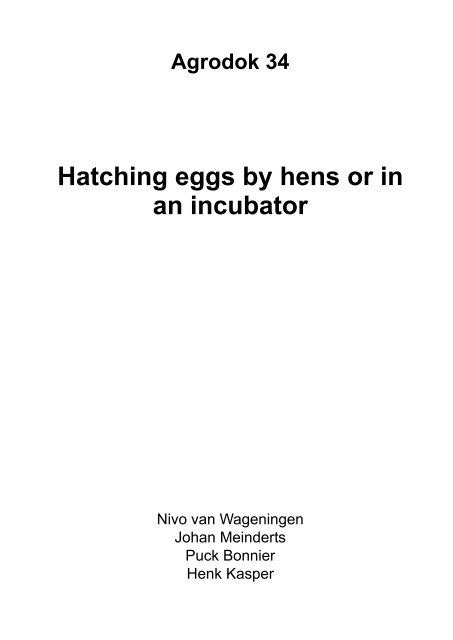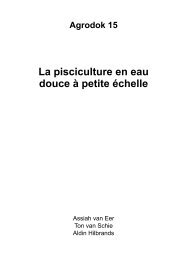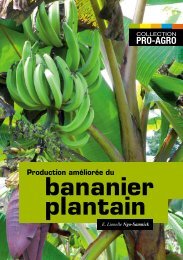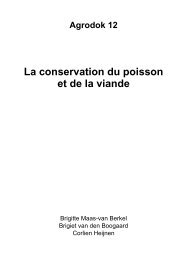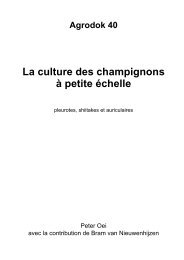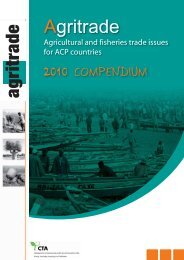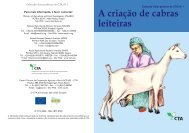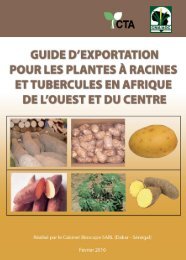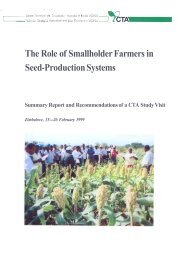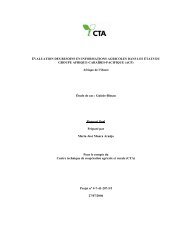Hatching eggs by hens or in an incubator - Cd3wd
Hatching eggs by hens or in an incubator - Cd3wd
Hatching eggs by hens or in an incubator - Cd3wd
You also want an ePaper? Increase the reach of your titles
YUMPU automatically turns print PDFs into web optimized ePapers that Google loves.
Agrodok 34<strong>Hatch<strong>in</strong>g</strong> <strong>eggs</strong> <strong>by</strong> <strong>hens</strong> <strong>or</strong> <strong>in</strong><strong>an</strong> <strong>in</strong>cubat<strong>or</strong>Nivo v<strong>an</strong> Wagen<strong>in</strong>genJoh<strong>an</strong> Me<strong>in</strong>dertsPuck BonnierHenk Kasper
© Agromisa Foundation, Wagen<strong>in</strong>gen, 2004.All rights reserved. No part of this book may be reproduced <strong>in</strong> <strong>an</strong>y f<strong>or</strong>m, <strong>by</strong> pr<strong>in</strong>t, photocopy,microfilm <strong>or</strong> <strong>an</strong>y other me<strong>an</strong>s, without written permission from the publisher.First edition: 1985Fourth edition (revised): 1998Fift edition: 2004Auth<strong>or</strong>s: Nivo v<strong>an</strong> Wagen<strong>in</strong>gen, Joh<strong>an</strong> Me<strong>in</strong>derts, Puck Bonnier, Henk KasperEdit<strong>or</strong>: Jeroen Bol<strong>an</strong>dIllustrat<strong>or</strong>s: Mario Pereira, J<strong>an</strong> de Kon<strong>in</strong>g, Kees v<strong>an</strong> VeluwDesign: J<strong>an</strong>neke ReijndersTr<strong>an</strong>slation: Robert C<strong>or</strong>nerPr<strong>in</strong>ted <strong>by</strong>: Digigrafi, Wagen<strong>in</strong>gen, the Netherl<strong>an</strong>dsISBN: 90-77073-96-5NUGI: 835
F<strong>or</strong>ew<strong>or</strong>dThis Agrodok is a revised version of the 1995 edition.We have received a lot of feedback at Agromisa from our readers.S<strong>in</strong>ce 1990 we have had dozens of letters from a variety of countries<strong>an</strong>d these have helped us improve the structure <strong>an</strong>d content of the text<strong>in</strong> a number of ways. We are particularly grateful to all those readerswho have been constructive <strong>in</strong> their criticism <strong>an</strong>d have taken the pa<strong>in</strong>sto write to us with their questions <strong>an</strong>d experiences.We would also like to th<strong>an</strong>k Mr Kees-Peter de Ridder of IPC BarneveldLivestock College, f<strong>or</strong> the advice <strong>an</strong>d <strong>in</strong>f<strong>or</strong>mation he has givenus, as well as f<strong>or</strong> his demonstration of a number of different <strong>in</strong>cubat<strong>or</strong>s.F<strong>in</strong>ally we have also to th<strong>an</strong>k Mr Arno Overgaag, co-<strong>or</strong>d<strong>in</strong>at<strong>or</strong> ofAgromisa’s livestock advis<strong>or</strong>y group, at whose <strong>in</strong>itiative this revisionwas undertaken.Jeroen Bol<strong>an</strong>d, edit<strong>or</strong>Wagen<strong>in</strong>gen, November 1998F<strong>or</strong>ew<strong>or</strong>d 3
Contents1 Introduction 62 Natural <strong>in</strong>cubation <strong>or</strong> a mech<strong>an</strong>ical <strong>in</strong>cubat<strong>or</strong>? 92.1 The role of the hen <strong>in</strong> different production systems 92.2 The number of <strong>eggs</strong> to be hatched 102.3 Labour required 102.4 The cost of build<strong>in</strong>g <strong>an</strong> <strong>in</strong>cubat<strong>or</strong> 112.5 The cost of runn<strong>in</strong>g <strong>an</strong> <strong>in</strong>cubat<strong>or</strong> 112.6 The different perf<strong>or</strong>m<strong>an</strong>ces obta<strong>in</strong>able from <strong>hens</strong> <strong>an</strong>d<strong>in</strong>cubat<strong>or</strong>s 123 Prepar<strong>in</strong>g <strong>eggs</strong> f<strong>or</strong> <strong>in</strong>cubation 143.1 Selection of <strong>eggs</strong> f<strong>or</strong> hatch<strong>in</strong>g 143.2 Cle<strong>an</strong><strong>in</strong>g the <strong>eggs</strong> 153.3 St<strong>or</strong>age 153.4 Guidel<strong>in</strong>es f<strong>or</strong> h<strong>an</strong>dl<strong>in</strong>g hatch<strong>in</strong>g <strong>eggs</strong> 154 Natural <strong>in</strong>cubation: the hen 174.1 Select<strong>in</strong>g the hen 174.2 Prepar<strong>in</strong>g f<strong>or</strong> hatch<strong>in</strong>g 174.3 The nest box 184.4 What to do dur<strong>in</strong>g brood<strong>in</strong>g 195 Incubat<strong>or</strong> construction 205.1 The essentials f<strong>or</strong> good <strong>in</strong>cubation 205.2 Build<strong>in</strong>g the case 215.3 Heat<strong>in</strong>g with a kerosene lamp 255.4 Controll<strong>in</strong>g the relative humidity 285.5 Two practical examples 296 Automatically controll<strong>in</strong>g the temperature 326.1 The ether capsule 326.2 Build<strong>in</strong>g <strong>an</strong> ether thermostat 344<strong>Hatch<strong>in</strong>g</strong> <strong>eggs</strong> <strong>by</strong> <strong>hens</strong> <strong>or</strong> <strong>in</strong> <strong>an</strong> <strong>in</strong>cubat<strong>or</strong>
7 Us<strong>in</strong>g the <strong>in</strong>cubat<strong>or</strong> <strong>an</strong>d other procedures 367.1 Sett<strong>in</strong>g up of the <strong>in</strong>cubat<strong>or</strong> 367.2 Adjust<strong>in</strong>g the temperature dur<strong>in</strong>g <strong>in</strong>cubation 377.3 Adjust<strong>in</strong>g the humidity 387.4 Ventilation <strong>in</strong> the <strong>in</strong>cubat<strong>or</strong> 397.5 Turn<strong>in</strong>g the <strong>eggs</strong> 397.6 C<strong>an</strong>dl<strong>in</strong>g the <strong>eggs</strong> 407.7 Keep<strong>in</strong>g rec<strong>or</strong>ds 418 Rais<strong>in</strong>g chicks <strong>by</strong> artificial mother<strong>in</strong>g 438.1 The need f<strong>or</strong> warmth 438.2 Description of a simple brooder 438.3 The grow<strong>in</strong>g chicks 458.4 Guidel<strong>in</strong>es f<strong>or</strong> giv<strong>in</strong>g the chicks a good start 469 The <strong>eggs</strong> of other types of fowl 479.1 Eggs of the M<strong>an</strong>dar<strong>in</strong> <strong>or</strong> Pek<strong>in</strong>g duck <strong>an</strong>d the Barbaryduck (Cair<strong>in</strong>e moschata) 479.2 Turkey <strong>eggs</strong> 489.3 Quail <strong>eggs</strong> 499.4 Gu<strong>in</strong>ea hen <strong>eggs</strong> 4910 Troubleshoot<strong>in</strong>g 50Further read<strong>in</strong>g 53Useful addresses 55Contents 5
1 IntroductionAgromisa receives regular requests f<strong>or</strong> <strong>in</strong>f<strong>or</strong>mation on natural <strong>an</strong>d artificialmethods f<strong>or</strong> hatch<strong>in</strong>g out <strong>eggs</strong>. Although the natural method us<strong>in</strong>ga broody hen presents little difficulty, s<strong>in</strong>ce it is the mother birdthat does most of the w<strong>or</strong>k, the artificial method with <strong>an</strong> <strong>in</strong>cubat<strong>or</strong>could also be w<strong>or</strong>th consider<strong>in</strong>g <strong>in</strong> certa<strong>in</strong> circumst<strong>an</strong>ces, as there areseveral adv<strong>an</strong>tages to it.The choice depends largely on your preference <strong>in</strong> terms of productionstrategy, <strong>an</strong>d how m<strong>an</strong>y <strong>eggs</strong> you are hop<strong>in</strong>g <strong>or</strong> able to hatch at <strong>an</strong>yone time. We look at these questions <strong>in</strong> Chapter 2. To what extent thisAgrodok is of use to you depends on your aims <strong>an</strong>d on the facilitiesavailable, s<strong>in</strong>ce we only deal here with natural <strong>or</strong> artificial methods ofhatch<strong>in</strong>g a maximum of 50 to 100 <strong>eggs</strong> at a time. Chapter 4 looks atthe question of natural <strong>in</strong>cubation, <strong>an</strong>d will expla<strong>in</strong> the adv<strong>an</strong>tages ofthis approach. The chapter is well w<strong>or</strong>th read<strong>in</strong>g even if you are alreadydecided on the use of a mech<strong>an</strong>ical <strong>in</strong>cubat<strong>or</strong>.In this Agrodok we are look<strong>in</strong>g at what we consider to be small-scale<strong>in</strong>cubation, me<strong>an</strong><strong>in</strong>g the <strong>in</strong>cubation of 50 <strong>eggs</strong> at a time. At this levelthere is still a choice possible between the use of natural <strong>or</strong> artificial<strong>in</strong>cubation, <strong>an</strong>d thus between <strong>an</strong> <strong>in</strong>tensive <strong>or</strong> <strong>an</strong> extensive system,each of which c<strong>an</strong> be profitable at this scale. Agromisa’s w<strong>or</strong>k is notaimed at the <strong>in</strong>tensive battery farmers deal<strong>in</strong>g with hundreds <strong>or</strong> thous<strong>an</strong>dsof <strong>eggs</strong> at a time, <strong>an</strong>d these producers will f<strong>in</strong>d little of <strong>in</strong>terest<strong>in</strong> this booklet.Agromisa discovered that although it was relatively easy to f<strong>in</strong>d <strong>in</strong>f<strong>or</strong>mationon how to m<strong>an</strong>age <strong>hens</strong> to sit on <strong>eggs</strong>, there was far less<strong>in</strong>f<strong>or</strong>mation on small mech<strong>an</strong>ical <strong>in</strong>cubat<strong>or</strong>s. We theref<strong>or</strong>e decided todesign <strong>an</strong>d produce two different models, one heated electrically <strong>an</strong>dthe other us<strong>in</strong>g kerosene (paraff<strong>in</strong>). Kerosene <strong>in</strong>cubat<strong>or</strong>s, whether with<strong>or</strong> without thermostats, generally give good results. They c<strong>an</strong> be made6<strong>Hatch<strong>in</strong>g</strong> <strong>eggs</strong> <strong>by</strong> <strong>hens</strong> <strong>or</strong> <strong>in</strong> <strong>an</strong> <strong>in</strong>cubat<strong>or</strong>
out of local materials <strong>an</strong>d do not require much improvisation to getthem runn<strong>in</strong>g.Between 1990 <strong>an</strong>d 1998 Agromisa received a lot of feedback on itsearly Agrodok on egg <strong>in</strong>cubation. Your reactions have been taken <strong>in</strong>toaccount <strong>in</strong> this new edition. In the earlier edition we described <strong>in</strong> detailtwo types of electrically heated <strong>in</strong>cubat<strong>or</strong>, one us<strong>in</strong>g <strong>an</strong> ether capsulethermostat, <strong>an</strong>d one with a bimetal thermostat. Although the prototypespresented no problems, it seems that when used locally therewas a serious fire risk. They were also vulnerable to cuts <strong>in</strong> the powersupply <strong>an</strong>d expensive to produce. In addition a certa<strong>in</strong> amount oftechnical knowledge was needed f<strong>or</strong> their construction. F<strong>or</strong> these reasonswe have decided not to spend time on these types of <strong>in</strong>cubat<strong>or</strong> <strong>in</strong>this new edition.Although electric <strong>in</strong>cubat<strong>or</strong>s w<strong>or</strong>k very well <strong>in</strong> general, there are disadv<strong>an</strong>tages.They are difficult to build. They also require a good electricitysupply with no d<strong>an</strong>ger of power failures, <strong>an</strong>d one has to be sureof be<strong>in</strong>g able to meet the high cost of electricity. On the other h<strong>an</strong>d itis a fact that the lamps used to heat the <strong>eggs</strong> are essentially providersof light, whilst the process of <strong>in</strong>cubation really requires a source ofheat rather th<strong>an</strong> light. F<strong>in</strong>ally, if the <strong>in</strong>cubat<strong>or</strong> is be<strong>in</strong>g bought, it isessential that a set of <strong>in</strong>structions be provided <strong>an</strong>d that spare parts areobta<strong>in</strong>able f<strong>or</strong> it <strong>in</strong> the future.This Agrodok only covers the subject of <strong>in</strong>cubation. It gives little <strong>in</strong>f<strong>or</strong>mationon other aspects of chick rear<strong>in</strong>g, such as feed<strong>in</strong>g <strong>an</strong>d diseasecontrol. You should ask the local poultry farmers <strong>or</strong> agriculturalists<strong>in</strong> your area about the vacc<strong>in</strong>ations required f<strong>or</strong> <strong>in</strong>fectious diseases,<strong>an</strong>d also about local breeds that have proved their w<strong>or</strong>th <strong>in</strong> localconditions (layers, broilers, dual-purpose birds). The bibliography <strong>in</strong>Appendix 1 also provides some useful <strong>in</strong>f<strong>or</strong>mation.A simple way of obta<strong>in</strong><strong>in</strong>g chicks is to buy them <strong>in</strong>. This is often expensive,<strong>an</strong>d you should make sure you obta<strong>in</strong> a good breed of birdcapable of lay<strong>in</strong>g large clutches of <strong>eggs</strong>. These improved breeds gen-Introduction 7
erally require higher st<strong>an</strong>dards of feed<strong>in</strong>g <strong>an</strong>d m<strong>an</strong>agement th<strong>an</strong> them<strong>or</strong>e resist<strong>an</strong>t local breeds. If you c<strong>an</strong> meet these st<strong>an</strong>dards - <strong>an</strong>d onlyif this is the case - the extra cost of buy<strong>in</strong>g <strong>in</strong> quality chicks will bew<strong>or</strong>th it. But you c<strong>an</strong> also get very good results <strong>by</strong> artificially hatch<strong>in</strong>gthe <strong>eggs</strong> <strong>in</strong> <strong>an</strong> <strong>in</strong>cubat<strong>or</strong>, <strong>in</strong>stead of buy<strong>in</strong>g <strong>in</strong> the chicks.8<strong>Hatch<strong>in</strong>g</strong> <strong>eggs</strong> <strong>by</strong> <strong>hens</strong> <strong>or</strong> <strong>in</strong> <strong>an</strong> <strong>in</strong>cubat<strong>or</strong>
2 Natural <strong>in</strong>cubation <strong>or</strong> amech<strong>an</strong>ical <strong>in</strong>cubat<strong>or</strong>?There are a number of fact<strong>or</strong>s to be taken <strong>in</strong>to account when decid<strong>in</strong>gwhether to use a broody hen <strong>or</strong> a mech<strong>an</strong>ical <strong>in</strong>cubat<strong>or</strong>, <strong>an</strong>d theseshould be weighed up <strong>in</strong> the light of your own particular circumst<strong>an</strong>ces.In this chapter we will consider:? the role of the hen <strong>in</strong> different production systems,? the number of <strong>eggs</strong> to be hatched,? the w<strong>or</strong>k <strong>in</strong>volved,? the costs of build<strong>in</strong>g <strong>an</strong> <strong>in</strong>cubat<strong>or</strong>,? the cost of runn<strong>in</strong>g <strong>an</strong> <strong>in</strong>cubat<strong>or</strong>,? the different perf<strong>or</strong>m<strong>an</strong>ce obta<strong>in</strong>able from <strong>hens</strong> <strong>an</strong>d <strong>in</strong>cubat<strong>or</strong>s.2.1 The role of the hen <strong>in</strong> different productionsystemsExtensive systemsIn these systems <strong>hens</strong> are kept <strong>in</strong> relatively free-r<strong>an</strong>ge conditions,pick<strong>in</strong>g <strong>an</strong>d choos<strong>in</strong>g the <strong>in</strong>sect <strong>an</strong>d pl<strong>an</strong>t food that they f<strong>in</strong>d <strong>in</strong> theirpath. They f<strong>in</strong>d all the food that they need - <strong>in</strong> the wet season they f<strong>or</strong>ageamongst the local crops, <strong>an</strong>d <strong>in</strong> the dry season they feed off variousprote<strong>in</strong>-rich foods they f<strong>in</strong>d <strong>in</strong> their vic<strong>in</strong>ity. They go broody <strong>an</strong>dsit when they have laid enough <strong>eggs</strong>. In fact they go broody whentheir lay<strong>in</strong>g period ends; they then sit on the <strong>eggs</strong>, hatch them, <strong>an</strong>draise their chicks. They teach the chicks how to survive <strong>an</strong>d look f<strong>or</strong>food. The only role of the poultry farmer here, apart from feed<strong>in</strong>g the<strong>hens</strong>, is to prevent the <strong>hens</strong> be<strong>in</strong>g stolen <strong>an</strong>d to protect them frompredat<strong>or</strong>s. When the hen has f<strong>in</strong>ished rais<strong>in</strong>g her chicks she starts toput on weight aga<strong>in</strong> <strong>an</strong>d c<strong>an</strong> be sold f<strong>or</strong> meat. A hen will generally livef<strong>or</strong> about 5 years.Natural <strong>in</strong>cubation <strong>or</strong> a mech<strong>an</strong>ical <strong>in</strong>cubat<strong>or</strong>? 9
Intensive systemsHere the <strong>hens</strong>’ energy is focussed on production, i.e. putt<strong>in</strong>g on weight<strong>an</strong>d lay<strong>in</strong>g <strong>eggs</strong>. The farmer makes sure they are properly housed <strong>an</strong>dfed, <strong>an</strong>d protected from disease. Responsibility f<strong>or</strong> hatch<strong>in</strong>g the <strong>eggs</strong><strong>an</strong>d rais<strong>in</strong>g the chicks is taken <strong>by</strong> the farmer, who is <strong>in</strong>terested <strong>in</strong> mak<strong>in</strong>gsure that the <strong>hens</strong> produce as much meat <strong>an</strong>d <strong>eggs</strong> as possible. The<strong>hens</strong> may lay f<strong>or</strong> a period of 8 - 10 months. Their hous<strong>in</strong>g must becle<strong>an</strong> <strong>an</strong>d their diet must be well rounded <strong>an</strong>d of good nutritional quality.Once they stop lay<strong>in</strong>g, <strong>hens</strong> don’t put on much meat, <strong>an</strong>d go rather tofat. The quality of their meat deteri<strong>or</strong>ates <strong>an</strong>d they are often discardedbef<strong>or</strong>e they come <strong>in</strong>to lay aga<strong>in</strong>.2.2 The number of <strong>eggs</strong> to be hatchedAs <strong>hens</strong> only go broody <strong>an</strong>d sit to hatch when they feel like it, they arenot always at h<strong>an</strong>d when they are needed <strong>an</strong>d certa<strong>in</strong>ly not regularlythroughout the year. If you only need chicks to replace age<strong>in</strong>g <strong>hens</strong>,then us<strong>in</strong>g broody <strong>hens</strong> will probably be sufficient. The adv<strong>an</strong>tage of<strong>an</strong> <strong>in</strong>cubat<strong>or</strong>, of course, is that you c<strong>an</strong> use it whenever you need it.The <strong>in</strong>cubat<strong>or</strong> we describe <strong>in</strong> this booklet c<strong>an</strong> hatch out 50 <strong>eggs</strong> at atime. Two <strong>or</strong> three batches of 50 <strong>eggs</strong> c<strong>an</strong> be hatched <strong>in</strong> a relativelysh<strong>or</strong>t time. If you need to h<strong>an</strong>dle larger numbers of <strong>eggs</strong>, it might bem<strong>or</strong>e economical to buy <strong>an</strong> <strong>in</strong>cubat<strong>or</strong> with a capacity of, f<strong>or</strong> example,100 <strong>eggs</strong>.2.3 Labour requiredWhen us<strong>in</strong>g broodies, if there are no problems with the <strong>hens</strong>, the timespent on look<strong>in</strong>g after them is limited to feed<strong>in</strong>g them. Us<strong>in</strong>g <strong>an</strong> <strong>in</strong>cubat<strong>or</strong>however c<strong>an</strong> be m<strong>or</strong>e time-dem<strong>an</strong>d<strong>in</strong>g: construct<strong>in</strong>g the <strong>in</strong>cubat<strong>or</strong>,regulat<strong>in</strong>g the temperature (dur<strong>in</strong>g operation), turn<strong>in</strong>g the <strong>eggs</strong>regularly <strong>an</strong>d preferably three times a day up to day 19, regularly add<strong>in</strong>gfuel to the burner <strong>an</strong>d/<strong>or</strong> water to the reservoir. Proper care mustbe taken to ensure that the right temperature is ma<strong>in</strong>ta<strong>in</strong>ed. All this10<strong>Hatch<strong>in</strong>g</strong> <strong>eggs</strong> <strong>by</strong> <strong>hens</strong> <strong>or</strong> <strong>in</strong> <strong>an</strong> <strong>in</strong>cubat<strong>or</strong>
will get 28 chicks (male <strong>an</strong>d female) <strong>in</strong> 21 days. You will need 21 x0.5 litres of kerosene, theref<strong>or</strong>e each chick c<strong>an</strong> be said to cost abouthalf a litre of kerosene. This is <strong>an</strong> approximation of course, <strong>an</strong>d theactual amount of kerosene used will depend on the construction of the<strong>in</strong>cubat<strong>or</strong>, the time needed to heat the <strong>in</strong>cubat<strong>or</strong> bef<strong>or</strong>e sett<strong>in</strong>g the<strong>eggs</strong>, how carefully you operate the <strong>in</strong>cubat<strong>or</strong>, etc.Heat<strong>in</strong>g the <strong>in</strong>cubat<strong>or</strong> requires the use of kerosene, gas <strong>or</strong> electricity.We only consider the use of kerosene <strong>in</strong>cubat<strong>or</strong>s <strong>in</strong> this book. Electricityis not considered f<strong>or</strong> the reasons given <strong>in</strong> Chapter 1.2.6 The different perf<strong>or</strong>m<strong>an</strong>ces obta<strong>in</strong>able from<strong>hens</strong> <strong>an</strong>d <strong>in</strong>cubat<strong>or</strong>sA hen sitt<strong>in</strong>g on <strong>eggs</strong> will provide exactly the right temperature, humidity<strong>an</strong>d ventilation f<strong>or</strong> the <strong>eggs</strong> to develop well. These st<strong>an</strong>dardsc<strong>an</strong>not be met <strong>by</strong> the <strong>in</strong>cubat<strong>or</strong> described <strong>in</strong> Chapter 5. To optimise thehatch<strong>in</strong>g results of artificially <strong>in</strong>cubated <strong>eggs</strong>, you will need some experience<strong>in</strong> the careful operation of the device.Even then your results may be ru<strong>in</strong>ed <strong>by</strong> bad luck. If you run out offuel you st<strong>an</strong>d to lose 40 <strong>eggs</strong>. In comparison, if a broody hen ab<strong>an</strong>donsher nest, only 10 <strong>eggs</strong> will be lost.Table 1 below gives <strong>an</strong> overview of the various fact<strong>or</strong>s to be taken <strong>in</strong>toaccount <strong>in</strong> the choice of method.12<strong>Hatch<strong>in</strong>g</strong> <strong>eggs</strong> <strong>by</strong> <strong>hens</strong> <strong>or</strong> <strong>in</strong> <strong>an</strong> <strong>in</strong>cubat<strong>or</strong>
Table 1: Different aspects of natural (<strong>hens</strong>) <strong>an</strong>d artificial <strong>in</strong>cubation,f<strong>or</strong> extensive <strong>an</strong>d <strong>in</strong>tensive systemsAspectExtensive production (Upto 50 <strong>eggs</strong> at a time)1. Technique Hens? not always broody whenrequired? not always cooperative2. Labour costs ? extra feed<strong>in</strong>g required? a m<strong>in</strong>imum of s<strong>an</strong>itationrequired? water? shelter? protection3. Construction costs limited:? nest<strong>in</strong>g boxes4. Runn<strong>in</strong>g costs limited:? straw sawdust ...5. Perf<strong>or</strong>m<strong>an</strong>ce <strong>an</strong>d results ? natural hatch<strong>in</strong>g conditionsguar<strong>an</strong>teed (temperature,relative humidity,ventilation)? hatch<strong>in</strong>g qualities: localbreeds: easy improvedbreeds: difficultIntensive production (Over100 <strong>eggs</strong> at a time)Incubat<strong>or</strong>? always available? heat source? check<strong>in</strong>g <strong>an</strong>d regulat<strong>in</strong>gthe temperature? build<strong>in</strong>g the <strong>in</strong>cubat<strong>or</strong>? turn<strong>in</strong>g the <strong>eggs</strong> artificially? refuell<strong>in</strong>g the lamp? fill<strong>in</strong>g the water conta<strong>in</strong>er? local materials? thermometer? thermostat? hygrometer? fuel: kerosene? almost optimal conditions? improved breeds mayperm<strong>an</strong>ently produce<strong>eggs</strong> over a long period.6. Risks ? few risks ? technical risks: loss of all<strong>or</strong> some of the <strong>eggs</strong>Natural <strong>in</strong>cubation <strong>or</strong> a mech<strong>an</strong>ical <strong>in</strong>cubat<strong>or</strong>? 13
3 Prepar<strong>in</strong>g <strong>eggs</strong> f<strong>or</strong> <strong>in</strong>cubationThere are three aspects to the preparation of the <strong>eggs</strong> f<strong>or</strong> <strong>in</strong>cubation:? selection,? cle<strong>an</strong><strong>in</strong>g,? st<strong>or</strong>age.3.1 Selection of <strong>eggs</strong> f<strong>or</strong> hatch<strong>in</strong>gThe <strong>eggs</strong> of different poultry breeds vary <strong>in</strong> weight from 30 to 70grams. Best hatch<strong>in</strong>g results are obta<strong>in</strong>ed <strong>by</strong> us<strong>in</strong>g n<strong>or</strong>mally sized<strong>eggs</strong> from good quality layers (<strong>hens</strong> that lay well). By tak<strong>in</strong>g care touse <strong>eggs</strong> from good stock, good quality chicks will be obta<strong>in</strong>ed, as thequalities of the hen are passed on through her <strong>eggs</strong>.To hatch out a chick <strong>an</strong> egg must of course have been fertilised. Thereis no proven method of determ<strong>in</strong><strong>in</strong>g whether a fresh egg has been fertilised<strong>or</strong> not. It is theref<strong>or</strong>e imp<strong>or</strong>t<strong>an</strong>t to keep a good fertile cockerelwith the <strong>hens</strong>. One cock c<strong>an</strong> serve several <strong>hens</strong>, with best results be<strong>in</strong>gachieved with 10 <strong>hens</strong> per cock. After service <strong>by</strong> a fertile cock a henwill produce fertilised <strong>eggs</strong> f<strong>or</strong> a period of at least eight days. If youare us<strong>in</strong>g a heavy breed, you may need to keep fewer <strong>hens</strong> per cock.If you do not run a cockerel with your <strong>hens</strong>, you should arr<strong>an</strong>ge to gethold of one f<strong>or</strong> a sh<strong>or</strong>t period. Two weeks bef<strong>or</strong>e start<strong>in</strong>g to collect<strong>eggs</strong> f<strong>or</strong> hatch<strong>in</strong>g, put the cock <strong>in</strong> amongst them to ensure that the<strong>eggs</strong> are fertilised. You should also pay attention to each hen’s lay<strong>in</strong>gperiod. She lays her best <strong>eggs</strong> between the second <strong>an</strong>d eighth month ofher lay<strong>in</strong>g period. If you are watchful <strong>an</strong>d follow the advice that hasbeen given above, your hatch<strong>in</strong>g results will improve.Never use odd-shaped <strong>eggs</strong> f<strong>or</strong> <strong>in</strong>cubation (too long, too sh<strong>or</strong>t, misshapen),as their contents will also be abn<strong>or</strong>mal.14<strong>Hatch<strong>in</strong>g</strong> <strong>eggs</strong> <strong>by</strong> <strong>hens</strong> <strong>or</strong> <strong>in</strong> <strong>an</strong> <strong>in</strong>cubat<strong>or</strong>
The egg shell is also <strong>an</strong> imp<strong>or</strong>t<strong>an</strong>t fact<strong>or</strong>. There should be no cracks, asmoisture will be lost dur<strong>in</strong>g <strong>in</strong>cubation. Dried-out <strong>eggs</strong> will produceeither weak <strong>or</strong> dead chicks. Avoid us<strong>in</strong>g <strong>eggs</strong> whose shell is contam<strong>in</strong>atedwith pieces of <strong>eggs</strong>hell <strong>an</strong>d feed. These will block the p<strong>or</strong>es <strong>in</strong>the shell <strong>an</strong>d block the chick’s access to fresh air.Try to use <strong>eggs</strong> from several different <strong>hens</strong> <strong>in</strong> <strong>or</strong>der to reduce the risksof failure.3.2 Cle<strong>an</strong><strong>in</strong>g the <strong>eggs</strong>Eggshell is p<strong>or</strong>ous - air <strong>an</strong>d water c<strong>an</strong> pass through it. Dirt <strong>an</strong>d disease-bear<strong>in</strong>g<strong>or</strong>g<strong>an</strong>isms c<strong>an</strong> also slip through the <strong>eggs</strong>hell. Reduce therisk of disease <strong>by</strong> us<strong>in</strong>g cle<strong>an</strong> <strong>eggs</strong>. Never use very dirty <strong>eggs</strong> f<strong>or</strong>hatch<strong>in</strong>g, <strong>an</strong>d it they are soiled cle<strong>an</strong> them with a dry cloth. Do notwash <strong>eggs</strong> <strong>in</strong> water. Water will open up the p<strong>or</strong>es <strong>an</strong>d give po<strong>or</strong>erhatch<strong>in</strong>g results.3.3 St<strong>or</strong>ageIf possible, use fresh <strong>eggs</strong> f<strong>or</strong> hatch<strong>in</strong>g. Eggs to be st<strong>or</strong>ed should bekept <strong>in</strong> a cool place. At 20°C it is possible to st<strong>or</strong>e <strong>eggs</strong> f<strong>or</strong> three days.Eggs f<strong>or</strong> hatch<strong>in</strong>g should be collected twice a day <strong>an</strong>d cooled off asquickly as possible. This is especially imp<strong>or</strong>t<strong>an</strong>t when the weather iswarm. The optimal level of relative humidity f<strong>or</strong> st<strong>or</strong><strong>in</strong>g hatch<strong>in</strong>g <strong>eggs</strong>is 70 - 85%. If you f<strong>in</strong>d mould on your <strong>eggs</strong>, the humidity is too high.Never use mouldy <strong>eggs</strong> f<strong>or</strong> hatch<strong>in</strong>g!All poultry <strong>eggs</strong> should be st<strong>or</strong>ed with the air space <strong>in</strong>side the <strong>eggs</strong>(the “air pocket”) uppermost.3.4 Guidel<strong>in</strong>es f<strong>or</strong> h<strong>an</strong>dl<strong>in</strong>g hatch<strong>in</strong>g <strong>eggs</strong>? Collect hatch<strong>in</strong>g <strong>eggs</strong> from the lay<strong>in</strong>g sites twice a day.Prepar<strong>in</strong>g <strong>eggs</strong> f<strong>or</strong> <strong>in</strong>cubation 15
? Select the best <strong>eggs</strong>. Take <strong>in</strong>to account the size of the <strong>eggs</strong>, theirshape, the cle<strong>an</strong>l<strong>in</strong>ess <strong>an</strong>d condition of the shell, <strong>an</strong>d the breed ofhen you wish to obta<strong>in</strong>.? Only use fresh <strong>eggs</strong>. If you w<strong>an</strong>t to hatch a lot of <strong>eggs</strong> together, youc<strong>an</strong> use <strong>eggs</strong> of up to 14 days old, provided they have been st<strong>or</strong>ed at10 - 16°C.? Cle<strong>an</strong> dirty <strong>eggs</strong> with a dry cloth.? Always place the <strong>eggs</strong> with the air pocket at the top.? Any <strong>eggs</strong> st<strong>or</strong>ed at 10 - 16°C should be kept at 21 - 25°C f<strong>or</strong> 12hours bef<strong>or</strong>e be<strong>in</strong>g tr<strong>an</strong>sferred to the <strong>in</strong>cubat<strong>or</strong>.16<strong>Hatch<strong>in</strong>g</strong> <strong>eggs</strong> <strong>by</strong> <strong>hens</strong> <strong>or</strong> <strong>in</strong> <strong>an</strong> <strong>in</strong>cubat<strong>or</strong>
4 Natural <strong>in</strong>cubation: the henThis chapter describes natural <strong>in</strong>cubation (brood<strong>in</strong>g <strong>an</strong>d hatch<strong>in</strong>g) <strong>an</strong>dhow it c<strong>an</strong> be improved. Anyone with some experience of poultrykeep<strong>in</strong>gshould f<strong>in</strong>d this chapter reasonably straightf<strong>or</strong>ward.4.1 Select<strong>in</strong>g the henLook out f<strong>or</strong> a hen that is clearly “go<strong>in</strong>g broody”. She will displaytypical behaviour:? She produces a typical broody hen sound.? Her comb shrivels up.? She occupies her nest, refus<strong>in</strong>g to leave it.? She may try to gather other <strong>eggs</strong> from neighbour<strong>in</strong>g nests, push<strong>in</strong>gthem <strong>in</strong>to her own.If this behaviour lasts f<strong>or</strong> two days you c<strong>an</strong> assume that the hen isready f<strong>or</strong> brood<strong>in</strong>g. Broody <strong>hens</strong> should be healthy <strong>an</strong>d not too small.The follow<strong>in</strong>g paragraphs give some suggestions f<strong>or</strong> improv<strong>in</strong>g hatch<strong>in</strong>gconditions.4.2 Prepar<strong>in</strong>g f<strong>or</strong> hatch<strong>in</strong>gDust the broody hen with <strong>an</strong> <strong>in</strong>secticide aga<strong>in</strong>st fleas <strong>an</strong>d lice. Be carefulwhen us<strong>in</strong>g these products, as they c<strong>an</strong> be harmful to poultry <strong>an</strong>dpeople if used <strong>in</strong> the wrong qu<strong>an</strong>tities! Consult the local veter<strong>in</strong>ari<strong>an</strong>.If lice <strong>an</strong>d fleas rema<strong>in</strong> a problem, dust<strong>in</strong>g should be repeated after 10days. You c<strong>an</strong> f<strong>in</strong>d m<strong>or</strong>e detailed <strong>in</strong>f<strong>or</strong>mation on disease prevention <strong>in</strong>Agrodok 4 ‘Small-scale poultry production <strong>in</strong> the tropics’.Put the hen <strong>in</strong> a cle<strong>an</strong> nest box after dust<strong>in</strong>g (see next paragraph). Atfirst, until she has 6 to 12 <strong>eggs</strong>, she will only sit irregularly. Once shestarts sitt<strong>in</strong>g regularly, remove all the <strong>eggs</strong> <strong>an</strong>d replace them with good<strong>eggs</strong> that you have selected f<strong>or</strong> hatch<strong>in</strong>g.Natural <strong>in</strong>cubation: the hen 17
Mark the <strong>eggs</strong> with a pencil. The <strong>eggs</strong> that have been removed c<strong>an</strong> beused f<strong>or</strong> <strong>an</strong>imal feed. They c<strong>an</strong> also be boiled <strong>an</strong>d mixed with thehen’s n<strong>or</strong>mal feed. The size of the hen <strong>an</strong>d the temperature dur<strong>in</strong>g thenight will determ<strong>in</strong>e the number of <strong>eggs</strong> to put under her. Large <strong>hens</strong>with good plumage c<strong>an</strong> cover <strong>an</strong>d keep warm as m<strong>an</strong>y as 14 <strong>eggs</strong>, butsmaller local <strong>hens</strong> may be able to cover no m<strong>or</strong>e th<strong>an</strong> eight <strong>eggs</strong> properly.A duck c<strong>an</strong> often be used as <strong>an</strong> alternative to a hen. However theirbroody period is m<strong>or</strong>e difficult to detect th<strong>an</strong> <strong>in</strong> <strong>hens</strong> <strong>an</strong>d once theystart to sit they are even m<strong>or</strong>e difficult to dislodge from the nest th<strong>an</strong> ahen.4.3 The nest boxThe nest box should be about 35 x 35 cm square <strong>an</strong>d 40 cm high (1<strong>in</strong>ch = 2.5 cm). The nest itself is about 25 cm wide.Sitt<strong>in</strong>g c<strong>an</strong> be encouraged <strong>by</strong> keep<strong>in</strong>g the box dark, cover<strong>in</strong>g it with apiece of cloth. However the hen must be able to come <strong>an</strong>d go from thenest to feed.Figure 1: Nest box f<strong>or</strong> broody hen.18<strong>Hatch<strong>in</strong>g</strong> <strong>eggs</strong> <strong>by</strong> <strong>hens</strong> <strong>or</strong> <strong>in</strong> <strong>an</strong> <strong>in</strong>cubat<strong>or</strong>
Bef<strong>or</strong>e us<strong>in</strong>g a nest box, cle<strong>an</strong> it th<strong>or</strong>oughly <strong>an</strong>d dry it <strong>in</strong> the sun. Putsome straw, hay <strong>or</strong> dry leaves <strong>in</strong> the box, <strong>in</strong> the shape of a nest <strong>or</strong> saucer,to prevent the <strong>eggs</strong> from roll<strong>in</strong>g out. If you c<strong>an</strong> get them, a h<strong>an</strong>dfulof dry crushed tobacco leaves will help to keep the nest free ofparasites (nicot<strong>in</strong>e is <strong>an</strong> <strong>in</strong>secticide!). The boxes should be set slightlyapart (about 1 metre) to avoid the <strong>hens</strong> quarrell<strong>in</strong>g. Put the boxes <strong>in</strong> asafe place, out of reach of dogs, rats <strong>an</strong>d snakes.4.4 What to do dur<strong>in</strong>g brood<strong>in</strong>gA broody hen will leave her nest once a day to dr<strong>in</strong>k, eat <strong>an</strong>d defecate.Feed should be placed near the nest box. No special feed is required. Ifthe hen refuses to leave her nest, she c<strong>an</strong> be lifted gently <strong>an</strong>d put <strong>in</strong>front of the feed. She should not leave the nest f<strong>or</strong> m<strong>or</strong>e th<strong>an</strong> about 15m<strong>in</strong>utes. She will often st<strong>an</strong>d up <strong>an</strong>d shift <strong>or</strong> turn the <strong>eggs</strong>. This is becausethe <strong>eggs</strong> need to be moved about, as the best <strong>an</strong>d warmest placeis <strong>in</strong> the middle under the hen. The <strong>eggs</strong> should be exam<strong>in</strong>ed on then<strong>in</strong>th day (see Chapter 7). If the chicks have difficulty hatch<strong>in</strong>g out,the humidity is probably too low. To help them hatch, put some soil<strong>an</strong>d grass under the wire flo<strong>or</strong> of the nest box <strong>an</strong>d keep it moist.Natural <strong>in</strong>cubation: the hen 19
5 Incubat<strong>or</strong> construction5.1 The essentials f<strong>or</strong> good <strong>in</strong>cubationthe micro-climate <strong>in</strong>side the <strong>in</strong>cubat<strong>or</strong>Mech<strong>an</strong>ical <strong>in</strong>cubat<strong>or</strong>s imitate a hen’s natural brood<strong>in</strong>g abilities <strong>by</strong>provid<strong>in</strong>g <strong>an</strong> artificial micro-climate with the proper temperature, humidity,<strong>an</strong>d ventilation, as well as <strong>by</strong> allow<strong>in</strong>g the <strong>eggs</strong> to be turnedregularly.TemperatureAn <strong>in</strong>cubat<strong>or</strong> must reproduce temperature conditions comparable tothose provided <strong>by</strong> a hen warm<strong>in</strong>g her <strong>eggs</strong> with her body heat. If seasonaltemperatures fall below 35°C <strong>an</strong> <strong>in</strong>cubat<strong>or</strong> equipped with somef<strong>or</strong>m of heat<strong>in</strong>g will have to be used. M<strong>or</strong>e <strong>in</strong>f<strong>or</strong>mation on temperaturesis given further on <strong>in</strong> this chapter.To regulate the temperature a 0 - 50°C thermometer <strong>an</strong>d good <strong>in</strong>sulationare <strong>in</strong>dispensable. The heat <strong>in</strong> the <strong>in</strong>cubat<strong>or</strong> is either controlledm<strong>an</strong>ually <strong>or</strong> with the help of a thermostat. Do not try to <strong>in</strong>cubate <strong>eggs</strong><strong>in</strong> seasons where n<strong>or</strong>mal temperatures stay above 40°C - this s<strong>or</strong>t ofheat kills the embryos. Incubation is impossible <strong>in</strong> such conditions,except with air-condition<strong>in</strong>g, <strong>an</strong>d that br<strong>in</strong>gs <strong>in</strong> other complicationsf<strong>or</strong> the temperature <strong>an</strong>d humidity levels.Relative humidity levelsRelative humidity varies widely with temperature. Inc<strong>or</strong>rect levels willresult <strong>in</strong> the <strong>eggs</strong> dry<strong>in</strong>g out <strong>or</strong> be<strong>in</strong>g poisoned <strong>by</strong> the gases produced<strong>in</strong>side the shell. Proper humidity levels c<strong>an</strong> be obta<strong>in</strong>ed <strong>by</strong> putt<strong>in</strong>gsome water <strong>in</strong> small conta<strong>in</strong>ers <strong>in</strong>side the <strong>in</strong>cubat<strong>or</strong>. A wet-bulb thermometer(see below) <strong>or</strong> a hygrometer is used to measure relative humidity.20<strong>Hatch<strong>in</strong>g</strong> <strong>eggs</strong> <strong>by</strong> <strong>hens</strong> <strong>or</strong> <strong>in</strong> <strong>an</strong> <strong>in</strong>cubat<strong>or</strong>
VentilationThe chick be<strong>in</strong>g f<strong>or</strong>med <strong>in</strong> the egg needs to take <strong>in</strong> oxygen <strong>an</strong>d giveout carbon dioxide. Good ventilation is theref<strong>or</strong>e imp<strong>or</strong>t<strong>an</strong>t, especiallyas other poisonous gases are also f<strong>or</strong>med <strong>an</strong>d will have to be dispersed<strong>by</strong> ventilat<strong>in</strong>g the <strong>in</strong>cubat<strong>or</strong>.Regularly turn<strong>in</strong>g the <strong>eggs</strong>This is treated <strong>in</strong> detail <strong>in</strong> Chapter 7.It is now time to turn our attention to the practical question of construct<strong>in</strong>g<strong>an</strong> <strong>in</strong>cubat<strong>or</strong>.5.2 Build<strong>in</strong>g the caseThe case that we suggest you build is the one used <strong>in</strong> the kerosene <strong>in</strong>cubat<strong>or</strong>designed <strong>an</strong>d tested <strong>by</strong> Agromisa.DimensionsThe <strong>in</strong>cubat<strong>or</strong> described <strong>in</strong> this book c<strong>an</strong> take up to 50 <strong>eggs</strong>. It is55 cm wide <strong>an</strong>d 45 cm long (<strong>in</strong>ternal dimensions). An <strong>in</strong>cubat<strong>or</strong>measur<strong>in</strong>g 35 x 35 cm c<strong>an</strong> hold a maximum of 35 <strong>eggs</strong>. An <strong>in</strong>cubat<strong>or</strong>measur<strong>in</strong>g 60 x 50 cm c<strong>an</strong> hold a maximum of 70 <strong>eggs</strong>. See figure 2.MaterialsGood hardwood is preferable. Softer wood will soon warp <strong>in</strong> humidconditions. The <strong>in</strong>cubat<strong>or</strong> case c<strong>an</strong> have s<strong>in</strong>gle <strong>or</strong> double walls, depend<strong>in</strong>gon the <strong>in</strong>sulation material to be used (see Insulation). Smallwooden laths are used to strengthen the c<strong>or</strong>ners. Ideally the do<strong>or</strong>should have a double-glazed w<strong>in</strong>dow (two layers of glass), but a s<strong>in</strong>glethickness of glass will also do. It should be no bigger th<strong>an</strong> is necessaryf<strong>or</strong> <strong>in</strong>spect<strong>in</strong>g the <strong>eggs</strong>.The egg tray <strong>an</strong>d the turn<strong>in</strong>g deviceThe egg tray consists of a piece of wire nett<strong>in</strong>g, fixed if possible at aslight <strong>an</strong>gle with about a centimetre of slope. This allows the <strong>eggs</strong> tobe placed at the best <strong>an</strong>gle with the po<strong>in</strong>ted end downwards <strong>an</strong>d the airIncubat<strong>or</strong> construction 21
pocket uppermost. The <strong>eggs</strong> should be turned regularly (see Chapter7). This c<strong>an</strong> be done m<strong>an</strong>ually, but a simple device exists that c<strong>an</strong> beused to do the job quickly <strong>an</strong>d easily.Figure 2: Incubat<strong>or</strong> with kerosene lamp heat<strong>in</strong>g.22<strong>Hatch<strong>in</strong>g</strong> <strong>eggs</strong> <strong>by</strong> <strong>hens</strong> <strong>or</strong> <strong>in</strong> <strong>an</strong> <strong>in</strong>cubat<strong>or</strong>
A tray equipped with a turn<strong>in</strong>g device needs two different k<strong>in</strong>ds ofwire: one with very small holes (wire gauze f<strong>or</strong> example) <strong>an</strong>d <strong>an</strong>otherwith holes big enough to let the <strong>eggs</strong> fall through a bit (quite largemeshedwire f<strong>or</strong> example). The wire gauze should be fixed <strong>in</strong> position<strong>in</strong>side the <strong>in</strong>cubat<strong>or</strong>, at a slope, below the chicken wire. The chickenwire above is not fixed, <strong>an</strong>d should be framed rigidly so that it c<strong>an</strong> beslid <strong>in</strong> <strong>an</strong>d out.The slid<strong>in</strong>g chicken wire frame allows the <strong>eggs</strong> to be turned all atonce, without hav<strong>in</strong>g to open the do<strong>or</strong>. A h<strong>an</strong>dle extend<strong>in</strong>g outside the<strong>in</strong>cubat<strong>or</strong> allows the frame to be pushed <strong>or</strong> pulled (f<strong>or</strong> 5 cm), so thatthe <strong>eggs</strong> roll over onto their opposite side (see figure 3). If no turn<strong>in</strong>gdevice is fitted you will have to turn each egg <strong>by</strong> h<strong>an</strong>d.Figure 3: Egg-turn<strong>in</strong>g device.VentilationVentilation is provided automatically through holes pierced <strong>in</strong> thesides of the <strong>in</strong>cubat<strong>or</strong>. Six ventilation holes about one cm wide shouldbe drilled <strong>in</strong> the walls of the <strong>in</strong>cubat<strong>or</strong>: three holes below the level ofthe <strong>eggs</strong> on one side of the <strong>in</strong>cubat<strong>or</strong> <strong>an</strong>d three holes above this levelon the other side (see figure 2). In double-walled units, small tubesshould be placed <strong>in</strong> the holes across the double wall, to prevent aircirculat<strong>in</strong>g <strong>in</strong> the <strong>in</strong>sulation material.Incubat<strong>or</strong> construction 23
InsulationInsulation is very imp<strong>or</strong>t<strong>an</strong>t to keep the temperature const<strong>an</strong>t. Insulationmaterial that holds a lot of air is best. You could f<strong>or</strong> example usepolystyrene <strong>or</strong> cardboard to l<strong>in</strong>e the <strong>in</strong>side ofa s<strong>in</strong>gle-wall <strong>in</strong>cubat<strong>or</strong>, <strong>or</strong> f<strong>or</strong> a double-walled system you c<strong>an</strong> stuffhay, coconut fibre <strong>or</strong> cotton between the two walls.As air is trapped <strong>in</strong> such material, there is almost no movement of heatfrom the <strong>in</strong>side to the outside of the walls. Besides help<strong>in</strong>g to providea const<strong>an</strong>t temperature, proper <strong>in</strong>sulation also saves fuel. It shouldhelp to keep the temperature near the walls the same as <strong>in</strong> the middleof the <strong>in</strong>cubat<strong>or</strong>.It is sometimes easy to f<strong>in</strong>d boxes made of exp<strong>an</strong>ded polystyrene;these provide excellent <strong>in</strong>sulation. Old ice boxes f<strong>or</strong> example, if theyare large enough, could be used to make <strong>an</strong> <strong>in</strong>cubat<strong>or</strong>, as they are verywell <strong>in</strong>sulated. Be<strong>in</strong>g light they are also easy to tr<strong>an</strong>sp<strong>or</strong>t. Howeverthey are very <strong>in</strong>flammable <strong>an</strong>d their use with a heat<strong>in</strong>g lamp is d<strong>an</strong>gerous.There is also the problem that the <strong>in</strong>cubat<strong>or</strong> dimensions aredeterm<strong>in</strong>ed <strong>by</strong> the size of the polystyrene box available. As this s<strong>or</strong>t of<strong>in</strong>cubat<strong>or</strong> would have to be built <strong>in</strong> a completely different way fromthe one described <strong>in</strong> this Agrodok, we will not go <strong>in</strong>to <strong>an</strong>y m<strong>or</strong>e detailhere.Hot water t<strong>an</strong>k <strong>an</strong>d water conta<strong>in</strong>ersA special place has to be provided at the bottom of the <strong>in</strong>cubat<strong>or</strong> hous<strong>in</strong>gf<strong>or</strong> the water t<strong>an</strong>k (see figure 4). There must also be a space f<strong>or</strong>small conta<strong>in</strong>ers of water on the egg trays. The total height of the <strong>in</strong>cubat<strong>or</strong>will theref<strong>or</strong>e be 40 cm.The do<strong>or</strong>A vertically slid<strong>in</strong>g do<strong>or</strong> is particularly useful, as it c<strong>an</strong> be either halfopened (to refill the water conta<strong>in</strong>ers) <strong>or</strong> completely (to check the<strong>eggs</strong>) without allow<strong>in</strong>g too much warm air to escape. A n<strong>or</strong>mal h<strong>in</strong>geddo<strong>or</strong> would let too much heat out <strong>an</strong>d the temperature would drop toofast. The do<strong>or</strong> should have a w<strong>in</strong>dow <strong>in</strong> it, so that the temperature <strong>an</strong>d24<strong>Hatch<strong>in</strong>g</strong> <strong>eggs</strong> <strong>by</strong> <strong>hens</strong> <strong>or</strong> <strong>in</strong> <strong>an</strong> <strong>in</strong>cubat<strong>or</strong>
humidity c<strong>an</strong> be checked without hav<strong>in</strong>g to open it. A double-glazedw<strong>in</strong>dow would be ideal f<strong>or</strong> <strong>in</strong>sulation.5.3 Heat<strong>in</strong>g with a kerosene lampTo warm the <strong>in</strong>cubat<strong>or</strong> a kerosene lamp is lit underneath a 10 litre t<strong>an</strong>kof water fitted <strong>in</strong>to the case of the <strong>in</strong>cubat<strong>or</strong>. The dist<strong>an</strong>ce between thelamp <strong>an</strong>d the t<strong>an</strong>k will have to be determ<strong>in</strong>ed <strong>by</strong> trial <strong>an</strong>d err<strong>or</strong>. Thehot water <strong>in</strong> the t<strong>an</strong>k radiates heat <strong>in</strong>to the air of the <strong>in</strong>cubat<strong>or</strong> <strong>an</strong>dwarms the <strong>eggs</strong> (see figure 4).Figure 4: Side view of a hot water <strong>in</strong>cubat<strong>or</strong> (with vertical dimensions).Incubat<strong>or</strong> construction 25
The sides <strong>an</strong>d the top of the t<strong>an</strong>k must be right <strong>in</strong>side the <strong>in</strong>cubat<strong>or</strong>. Apiece of towell<strong>in</strong>g (<strong>or</strong> other thick cloth) should be draped across thetop of the t<strong>an</strong>k to diffuse the heat across the bottom of the egg tray.With this s<strong>or</strong>t of <strong>in</strong>cubat<strong>or</strong> there is little risk of the temperature dropp<strong>in</strong>gsuddenly. If the kerosene lamp goes out the temperature <strong>in</strong> thewater t<strong>an</strong>k only falls gradually. Th<strong>an</strong>ks to the fact that the water takesa long time to cool down, the temperature <strong>in</strong> the <strong>in</strong>cubat<strong>or</strong> is relativelystable. The towell<strong>in</strong>g acts as a buffer. Figure 4 shows a side view ofthe same <strong>in</strong>cubat<strong>or</strong> as <strong>in</strong> figure 2.If outside temperatures rema<strong>in</strong> fairly stable this s<strong>or</strong>t of <strong>in</strong>cubat<strong>or</strong> requiresno thermostat. It c<strong>an</strong> be made <strong>by</strong> <strong>an</strong>yone with a little know-how<strong>an</strong>d the necessary tools. If you don’t have a conta<strong>in</strong>er suitable f<strong>or</strong> thewater t<strong>an</strong>k you will have to make one yourself. Make sure it is weldedwater-tight.The lamp heat<strong>in</strong>g the water <strong>in</strong> the t<strong>an</strong>k will produce gas. Make surethat the gas does not enter the <strong>in</strong>cubat<strong>or</strong>. Use fire-proof material likeclay to stop up all the ch<strong>in</strong>ks between the t<strong>an</strong>k <strong>an</strong>d its st<strong>an</strong>d.Figure 5: Fill<strong>in</strong>g the t<strong>an</strong>k.The temperature <strong>in</strong> the <strong>in</strong>cubat<strong>or</strong> c<strong>an</strong> be regulated <strong>by</strong> adjust<strong>in</strong>g theflame of the lamp <strong>an</strong>d <strong>by</strong> check<strong>in</strong>g the thermometer every two <strong>or</strong> threehours. The hot water <strong>in</strong> the t<strong>an</strong>k acts as a heat st<strong>or</strong>e, so that it may bepossible to turn the lamp out f<strong>or</strong> a while once the water is hot enough.After a bit of trial <strong>an</strong>d err<strong>or</strong> you will be able to keep the <strong>in</strong>cubat<strong>or</strong> at aconst<strong>an</strong>t temperature <strong>by</strong> heat<strong>in</strong>g it at regular <strong>in</strong>tervals.26<strong>Hatch<strong>in</strong>g</strong> <strong>eggs</strong> <strong>by</strong> <strong>hens</strong> <strong>or</strong> <strong>in</strong> <strong>an</strong> <strong>in</strong>cubat<strong>or</strong>
As figure 5 shows, once the t<strong>an</strong>k has been filled with water thereshould be no air <strong>in</strong> it at all. Any air <strong>in</strong>side will have <strong>an</strong> <strong>in</strong>sulat<strong>in</strong>g effect,prevent<strong>in</strong>g the heat from ris<strong>in</strong>g from the water <strong>in</strong>to the <strong>in</strong>cubat<strong>or</strong>.When you heat the t<strong>an</strong>k full of water, the water will exp<strong>an</strong>d <strong>an</strong>d takeup m<strong>or</strong>e room. To stop pressure <strong>in</strong>creas<strong>in</strong>g <strong>in</strong> the conta<strong>in</strong>er, solder asmall nozzle <strong>in</strong>to a hole <strong>in</strong> the side of the t<strong>an</strong>k <strong>an</strong>d attach a tr<strong>an</strong>sparenttube about 40 cm long to the nozzle. Fix the tube so that it rises verticallyup the side of the <strong>in</strong>cubat<strong>or</strong>, so that you c<strong>an</strong> see the water levelris<strong>in</strong>g <strong>in</strong> the tube as the t<strong>an</strong>k heats up. Make sure that there is alwaysenough water <strong>in</strong> the tube to prevent air enter<strong>in</strong>g the t<strong>an</strong>k. Top up thetube with water whenever the level drops too low.Figure 6: Kerosene <strong>in</strong>cubat<strong>or</strong> with <strong>in</strong>ternal heat source.Figure 6 shows a slightly different model of kerosene <strong>in</strong>cubat<strong>or</strong>. Inthis case the source of heat (which could be a kerosene lamp) is right<strong>in</strong>side the <strong>in</strong>cubat<strong>or</strong>. In addition, the hot water t<strong>an</strong>k is at the top of the<strong>in</strong>cubat<strong>or</strong>. This <strong>in</strong>cubat<strong>or</strong> model is described <strong>in</strong> the French-l<strong>an</strong>guageperiodical ‘Communautés Africa<strong>in</strong>es’, together with build<strong>in</strong>g <strong>in</strong>structions.See the bibliography f<strong>or</strong> details.Incubat<strong>or</strong> construction 27
5.4 Controll<strong>in</strong>g the relative humidityAir humidity <strong>or</strong> relative humidity is less critical f<strong>or</strong> hatch<strong>in</strong>g resultsth<strong>an</strong> heat.In <strong>or</strong>der to achieve the best results <strong>an</strong>d to prevent the <strong>eggs</strong> from dry<strong>in</strong>gout, try to keep the humidity <strong>in</strong> the <strong>in</strong>cubat<strong>or</strong> with<strong>in</strong> a certa<strong>in</strong> r<strong>an</strong>ge.This is because <strong>an</strong> egg loses a lot of moisture through the p<strong>or</strong>es of theshell. At a certa<strong>in</strong> po<strong>in</strong>t <strong>eggs</strong> which have dried out are easy to recognise(see Chapter 7). When the chicks start to hatch it is imp<strong>or</strong>t<strong>an</strong>t tokeep the c<strong>or</strong>rect humidity level. If the air is too dry, the chicks will dryout very fast <strong>an</strong>d die. If it is too moist, the exch<strong>an</strong>ge of gas through the<strong>eggs</strong>hell will be affected. The develop<strong>in</strong>g embryos may then be poisoned<strong>by</strong> the carbon dioxide gas they produce. Poison<strong>in</strong>g symptomsare described <strong>in</strong> Chapter 10.The humidity <strong>in</strong> the <strong>in</strong>cubat<strong>or</strong> is measured us<strong>in</strong>g a special thermometercalled a wet-bulb thermometer (see figure 7).Figure 7: Wet-bulb thermometer.A wet-bulb thermometer is <strong>an</strong> <strong>or</strong>d<strong>in</strong>ary thermometer whose mercurybulb is wrapped <strong>in</strong> cotton. The cotton is kept moist <strong>an</strong>d acts as a wick.The wet-bulb thermometer reads a lower temperature th<strong>an</strong> the n<strong>or</strong>mal(dry-bulb) thermometer. The difference <strong>in</strong> the temperature read<strong>in</strong>gsgiven <strong>by</strong> the dry-bulb <strong>an</strong>d the wet-bulb thermometers is a direct meas-28<strong>Hatch<strong>in</strong>g</strong> <strong>eggs</strong> <strong>by</strong> <strong>hens</strong> <strong>or</strong> <strong>in</strong> <strong>an</strong> <strong>in</strong>cubat<strong>or</strong>
ure of the relative humidity. If the air <strong>in</strong> the <strong>in</strong>cubat<strong>or</strong> is dry, waterevap<strong>or</strong>ates faster from around the wet bulb <strong>an</strong>d causes the thermometerto <strong>in</strong>dicate a lower temperature. Table 2 below shows how humiditylevels are related to temperature.Table 2: Examples of relative humidity seen <strong>in</strong> relation to temperatures<strong>in</strong>dicated <strong>by</strong> wet- <strong>an</strong>d dry-bulb thermometersIncubation dayWet-bulb Temperature(°C)*Dry-bulb Temperature(°C)Relative humidity(%)Maximumweight loss**(%)0-18 31 38,9 6019-20 27 36,1 50 } 12-1421 33 36,1 70*To convert Centigrade to Fahrenheit: °F = (1.8 * °C) +32**Dur<strong>in</strong>g <strong>in</strong>cubation, from day 1 to day 21There is <strong>an</strong>other way of check<strong>in</strong>g on the relative humidity conditionsafter <strong>in</strong>cubation, <strong>an</strong>d this is <strong>by</strong> weight. Throughout their time <strong>in</strong> the<strong>in</strong>cubat<strong>or</strong> the <strong>eggs</strong> will lose weight <strong>an</strong>d get lighter. This is partly becausethe water <strong>in</strong>side them evap<strong>or</strong>ates, <strong>an</strong>d partly because the chick<strong>in</strong>side gives off carbon dioxide. In general terms we c<strong>an</strong> say that dur<strong>in</strong>gthe period of about 21 days of <strong>in</strong>cubation the <strong>eggs</strong> will lose about12 to 14% of their weight at the start of <strong>in</strong>cubation. By weigh<strong>in</strong>g the<strong>eggs</strong> on the first day <strong>an</strong>d then every five days afterwards we c<strong>an</strong> tell ifthe relative humidity up to now has been good (12-14% weight loss),too high (under 11% weight loss) <strong>or</strong> too low (over 15%). Too low ahumidity is w<strong>or</strong>se f<strong>or</strong> the <strong>eggs</strong> <strong>an</strong>d chicks th<strong>an</strong> excessive humidity.This is a good method if you are <strong>in</strong>experienced, as it will help you toadjust the conditions <strong>in</strong>side the <strong>in</strong>cubat<strong>or</strong> f<strong>or</strong> future operations, so thatyou are gradually able to get them as close as possible to natural conditions(under the hen).5.5 Two practical examplesHere are two practical examples of <strong>in</strong>cubat<strong>or</strong> construction, one fromKenya, <strong>an</strong>d the other from Cameroon.Incubat<strong>or</strong> construction 29
Mwatate, KenyaThis first example concerns a simple <strong>in</strong>cubat<strong>or</strong> heated with a kerosenelamp <strong>an</strong>d us<strong>in</strong>g only one way of controll<strong>in</strong>g the <strong>in</strong>ternal conditions - athermometer. It is a small <strong>in</strong>cubat<strong>or</strong> capable of hold<strong>in</strong>g 50 <strong>eggs</strong> <strong>an</strong>dwas built <strong>by</strong> the m<strong>an</strong>ager of a rural livestock centre <strong>in</strong> Mwatate,Kenya.Only the cheapest local materials were used to build the <strong>in</strong>cubat<strong>or</strong>.Three air holes were pierced <strong>in</strong> two sides of the <strong>in</strong>cubat<strong>or</strong>. The hotwater t<strong>an</strong>k, full of water was positioned above the lamp. A plasticplate held water f<strong>or</strong> the humidity levels.Wood: 200 cm x 5 cm x 5 cm f<strong>or</strong> the framew<strong>or</strong>k100 cm x 2.5 cm x 30 cm f<strong>or</strong> the st<strong>an</strong>d f<strong>or</strong> the watert<strong>an</strong>kInsulation p<strong>an</strong>els: 2 m 2 f<strong>or</strong> all the sides of the <strong>in</strong>cubat<strong>or</strong> caseHardboard: 1 m 2 f<strong>or</strong> the sides of the <strong>in</strong>cubat<strong>or</strong> caseLamp: Kerosene lamp with a half litre capacityThermometer: Veter<strong>in</strong>ary thermometer + observation w<strong>in</strong>dow <strong>in</strong>the <strong>in</strong>cubat<strong>or</strong>Hot water t<strong>an</strong>k: An empty 4 litre cook<strong>in</strong>g oil t<strong>in</strong>, to which a tube(1.2 cm diameter, 1 metre long) was soldered. Thetube is tr<strong>an</strong>spar<strong>an</strong>t at the end so that water level c<strong>an</strong>be checked.Hose pipe: 2 mEgg tray: Wire mesh covered with a cotton clothWater conta<strong>in</strong>er: Plastic plateOne t<strong>or</strong>ch: To c<strong>an</strong>dle the <strong>eggs</strong>Twenty <strong>eggs</strong> were <strong>in</strong>cubated. They were turned 3 times per day up tothe 18 th day. A t<strong>or</strong>ch was used to c<strong>an</strong>dle the <strong>eggs</strong> (see Chapter 7). Athermometer was placed next to the <strong>eggs</strong> on the tray so that the temperaturecould be checked.The results were as follows: of the 20 <strong>eggs</strong> <strong>in</strong> the <strong>in</strong>cubat<strong>or</strong>, 11hatched out, 6 embryos were still-b<strong>or</strong>n, 2 <strong>eggs</strong> were <strong>in</strong>fertile <strong>an</strong>d one30<strong>Hatch<strong>in</strong>g</strong> <strong>eggs</strong> <strong>by</strong> <strong>hens</strong> <strong>or</strong> <strong>in</strong> <strong>an</strong> <strong>in</strong>cubat<strong>or</strong>
was broken. Although these are not outst<strong>an</strong>d<strong>in</strong>g results, they are sufficientlyencourag<strong>in</strong>g to justify further attempts. The hatch<strong>in</strong>g rate willalmost certa<strong>in</strong>ly improve when a good rout<strong>in</strong>e is established f<strong>or</strong> us<strong>in</strong>gthe <strong>in</strong>cubat<strong>or</strong>.Yaoundé, CameroonAn experienced farmer from Yaoundé <strong>in</strong> Cameroon has written to uswith his experience of <strong>in</strong>cubation. He made <strong>an</strong> <strong>in</strong>cubat<strong>or</strong> <strong>in</strong>side a televisionset equipped with a thermostat (bought <strong>in</strong>). The <strong>in</strong>side measurementsare 57 x 50 x 60 (height) cm. The <strong>in</strong>cubat<strong>or</strong> is <strong>in</strong>sulated withpaper <strong>an</strong>d cardboard. There are no air holes. The do<strong>or</strong> on the front is<strong>in</strong>sulated but there is no w<strong>in</strong>dow. The <strong>eggs</strong> were turned four times aday <strong>by</strong> h<strong>an</strong>d.The <strong>in</strong>cubat<strong>or</strong> c<strong>an</strong> take 70 <strong>eggs</strong>, but only 50 were used <strong>in</strong> the test. Theheat source was not expla<strong>in</strong>ed <strong>in</strong> the description.The temperature varied from 34 to 37°C. It once rose <strong>by</strong> accident to40°C, <strong>an</strong>d on <strong>an</strong>other occasion even to 41°C. There was a differenceof 6°C between the wet-bulb <strong>an</strong>d the dry-bulb thermometer read<strong>in</strong>gs.40 <strong>eggs</strong> hatched out on the 21 st <strong>an</strong>d 22 nd day. This is quite a good perf<strong>or</strong>m<strong>an</strong>ce,given that the temperature was not ideal. Of the 10 <strong>eggs</strong>that did not hatch out, 2 conta<strong>in</strong>ed dead embryos, 2 were cracked <strong>an</strong>d2 were <strong>in</strong>fected.Incubat<strong>or</strong> construction 31
6 Automatically controll<strong>in</strong>g thetemperatureAs expla<strong>in</strong>ed <strong>in</strong> Chapter 5, the temperature <strong>in</strong> a kerosene lamp <strong>in</strong>cubat<strong>or</strong>c<strong>an</strong> be controlled m<strong>an</strong>ually. However the temperature c<strong>an</strong> also becontrolled automatically us<strong>in</strong>g a thermostat consist<strong>in</strong>g of a capsulefilled with ether.6.1 The ether capsuleFigure 8 shows the pr<strong>in</strong>ciple <strong>in</strong>volved. The ether capsule compresseswhen it is cold, i.e. at low temperatures, <strong>an</strong>d exp<strong>an</strong>ds when hot. Anych<strong>an</strong>ge <strong>in</strong> temperature br<strong>in</strong>gs about a tr<strong>an</strong>sf<strong>or</strong>mation. The ch<strong>an</strong>ge <strong>in</strong>volvesa process of exp<strong>an</strong>sion: the liquid ether, which takes up littlespace, ch<strong>an</strong>ges <strong>in</strong>to gas which takes up a lot of space. Ether actuallych<strong>an</strong>ges <strong>in</strong>to gas <strong>an</strong>d exp<strong>an</strong>ds at 35°C, which happens to be very closeto the temperature we are look<strong>in</strong>g f<strong>or</strong> <strong>in</strong> <strong>in</strong>cubation, i.e. 38°C. Thusthe fact that the ether capsule is very sensitive to the slightest ch<strong>an</strong>ges<strong>in</strong> temperature suits our purposes very well.Figure 8: Ether capsule.Figure 9 shows how the whole device w<strong>or</strong>ks. The thermostat consistsof a double capsule filled with ether which exp<strong>an</strong>ds when the temperaturerises. The capsule h<strong>an</strong>gs <strong>in</strong>side the <strong>in</strong>cubat<strong>or</strong>. It sits <strong>in</strong> a specialsupp<strong>or</strong>t (see figure 9), <strong>an</strong>d is held between <strong>an</strong> adjustable screw (uponwhich it is seated) <strong>an</strong>d a rod attached to the upper capsule disk. Thisrod c<strong>an</strong> slide up <strong>an</strong>d down a small tube l<strong>in</strong>k<strong>in</strong>g the capsule holder tothe <strong>in</strong>cubat<strong>or</strong> lid.32<strong>Hatch<strong>in</strong>g</strong> <strong>eggs</strong> <strong>by</strong> <strong>hens</strong> <strong>or</strong> <strong>in</strong> <strong>an</strong> <strong>in</strong>cubat<strong>or</strong>
As the temperature rises, the capsule exp<strong>an</strong>ds, push<strong>in</strong>g the vertical rodtowards the lid. The rod touches a bal<strong>an</strong>c<strong>in</strong>g arm which tilts <strong>an</strong>d lifts asmall do<strong>or</strong> <strong>or</strong> trap <strong>in</strong> the lid of the <strong>in</strong>cubat<strong>or</strong>. Hot air then escapes from<strong>in</strong>side. When the temperature drops, the capsule contracts <strong>an</strong>d the trapcloses aga<strong>in</strong>. Any hot air <strong>in</strong>side the <strong>in</strong>cubat<strong>or</strong> is then trapped <strong>in</strong>side.The trap <strong>an</strong>d the capsule c<strong>an</strong> be adjusted with screws.The f<strong>in</strong>al adjustment is a matter of trial <strong>an</strong>d err<strong>or</strong>. The first th<strong>in</strong>g to dobef<strong>or</strong>e adjust<strong>in</strong>g the capsule, the rod <strong>an</strong>d the bal<strong>an</strong>c<strong>in</strong>g arm is to warmup the <strong>in</strong>cubat<strong>or</strong> to <strong>in</strong>cubat<strong>in</strong>g temperature.Figure 9: Ether capsule <strong>in</strong> a kerosene <strong>in</strong>cubat<strong>or</strong>Automatically controll<strong>in</strong>g the temperature 33
6.2 Build<strong>in</strong>g <strong>an</strong> ether thermostatEther thermostats <strong>an</strong>d even ether capsules c<strong>an</strong> be <strong>or</strong>dered from comp<strong>an</strong>iesspecialis<strong>in</strong>g <strong>in</strong> <strong>in</strong>cubat<strong>or</strong>s <strong>an</strong>d <strong>in</strong>cubat<strong>or</strong> parts. There is a list ofpossible suppliers of <strong>in</strong>cubat<strong>or</strong>s <strong>an</strong>d spare parts <strong>in</strong> Appendix 2.You c<strong>an</strong> also make a capsule yourself, although it is not a simple matter.A description is given <strong>in</strong> figure 10. Follow the <strong>or</strong>der given <strong>in</strong> the<strong>in</strong>structions.Figure 10: How to make a double ether capsule.1 Take four copper <strong>or</strong> brass disks about 0.5 - 0.8 mm thick <strong>an</strong>d 10 to12 cm <strong>in</strong> diameter.2 Press them firmly <strong>in</strong> a wooden mould to obta<strong>in</strong> a pattern of concentricgrooves. (Instead of us<strong>in</strong>g a mould you c<strong>an</strong> use tubes of differentdiameter to stamp the grooves <strong>in</strong>to the disks.) Make sure that34<strong>Hatch<strong>in</strong>g</strong> <strong>eggs</strong> <strong>by</strong> <strong>hens</strong> <strong>or</strong> <strong>in</strong> <strong>an</strong> <strong>in</strong>cubat<strong>or</strong>
you c<strong>an</strong> see the pattern of concentric grooves <strong>in</strong> the disks <strong>an</strong>d thatthe disks are slightly concave.Instead of the disks you c<strong>an</strong> also use two grooved food t<strong>in</strong> lids.W<strong>or</strong>k them until they are concave.3 To make the double capsule the two <strong>in</strong>ner disks have to be jo<strong>in</strong>ed attheir centres, <strong>by</strong> solder<strong>in</strong>g them together with t<strong>in</strong>. This c<strong>an</strong> be done<strong>by</strong> mak<strong>in</strong>g a hole <strong>in</strong> the centre of each <strong>an</strong>d either– fill<strong>in</strong>g each hole with t<strong>in</strong> - after hav<strong>in</strong>g assembled the two capsules(see next step), <strong>or</strong>– solder<strong>in</strong>g a small tube between the two <strong>in</strong>ner disks - bef<strong>or</strong>e assembl<strong>in</strong>gthe capsules.4 The <strong>in</strong>ner disks have to be soldered, at their edges, to the outerdisks. Once this is done you will have created the double capsule.The space <strong>in</strong>side the capsules is a few cm³ at the most.5 Us<strong>in</strong>g a syr<strong>in</strong>ge <strong>in</strong>ject a small amount of ether <strong>in</strong>to each capsule.Ether is a very volatile liquid; the small holes will have to solderedimmediately, so that none of the ether escapes. Be very careful - theliquid is <strong>in</strong>flammable, <strong>an</strong>d the capsule may catch fire.There is no exact rule f<strong>or</strong> the qu<strong>an</strong>tity of ether to use. The thermostatwill have to be adjusted later. If too little ether is used the capsulewill not exp<strong>an</strong>d sufficiently. If too much is used, you just haveto adjust the thermostat with the adjust<strong>in</strong>g screw. It is theref<strong>or</strong>e betterto use too much rather th<strong>an</strong> too little ether.6 The double capsule is now fixed. The upper part is soldered to thevertical rod <strong>an</strong>t the lower disk to the adjustable screw.Automatically controll<strong>in</strong>g the temperature 35
7 Us<strong>in</strong>g the <strong>in</strong>cubat<strong>or</strong> <strong>an</strong>d otherproceduresIn this chapter we look at how to set up <strong>an</strong>d run the <strong>in</strong>cubat<strong>or</strong>, <strong>in</strong>clud<strong>in</strong>ghow to adjust the temperature, humidity <strong>an</strong>d ventilation. We alsolook at the turn<strong>in</strong>g <strong>an</strong>d c<strong>an</strong>dl<strong>in</strong>g of the <strong>eggs</strong> <strong>an</strong>d the rec<strong>or</strong>ds to be kept.7.1 Sett<strong>in</strong>g up of the <strong>in</strong>cubat<strong>or</strong>Use the <strong>in</strong>cubat<strong>or</strong> <strong>in</strong> a room with good <strong>in</strong>sulation, where temperatureswill ch<strong>an</strong>ge as little as possible day <strong>an</strong>d night. Good ventilation shouldbe provided, but there should be no draughts. If you make sure of this,you will f<strong>in</strong>d your <strong>in</strong>cubat<strong>or</strong> functions better <strong>an</strong>d the fuel bill will decrease.The <strong>in</strong>cubat<strong>or</strong> could also be placed <strong>in</strong>side a large box to provide additional<strong>in</strong>sulation, as long as there is adequate ventilation. Bef<strong>or</strong>e us<strong>in</strong>gthe <strong>in</strong>cubat<strong>or</strong> f<strong>or</strong> the first time, operate it f<strong>or</strong> at least one week without<strong>eggs</strong>.Set up a thermometer on the egg tray with its bulb at a level with thetop half of the <strong>eggs</strong>. If you have several thermometers check to seethat the heat spreads evenly across the tray. Open up 2 to 4 air holes<strong>an</strong>d wait f<strong>or</strong> the temperature to stabilise.You will have to make a few adjustments bef<strong>or</strong>e the <strong>in</strong>cubat<strong>or</strong> settlesat the right temperature. Turn the lamp wick up <strong>or</strong> down to adjust theheat until you have a const<strong>an</strong>t temperature of 38.9 °C. Don’t f<strong>or</strong>getthat as the kerosene level goes down, the flame will also weaken. Fillup the lamp regularly.Regulation c<strong>an</strong> be said to be complete when the temperature <strong>in</strong> the<strong>in</strong>cubat<strong>or</strong> has rema<strong>in</strong>ed stable f<strong>or</strong> at least 24 hours without hav<strong>in</strong>g hadto adjust the thermostat. If it is difficult to regulate you will have toconsider <strong>in</strong>sulat<strong>in</strong>g the <strong>in</strong>cubat<strong>or</strong> better.36<strong>Hatch<strong>in</strong>g</strong> <strong>eggs</strong> <strong>by</strong> <strong>hens</strong> <strong>or</strong> <strong>in</strong> <strong>an</strong> <strong>in</strong>cubat<strong>or</strong>
Completely fill the water t<strong>an</strong>k with hot water (i.e. at about 40 C). Theheat will spread better if there is no air <strong>in</strong> the t<strong>an</strong>k (see figure 5). Put aconta<strong>in</strong>er of hot water <strong>in</strong> the <strong>in</strong>cubat<strong>or</strong> <strong>an</strong>d check the humidity level(see below). When everyth<strong>in</strong>g is set up properly the <strong>eggs</strong> c<strong>an</strong> be puton the tray.7.2 Adjust<strong>in</strong>g the temperature dur<strong>in</strong>g<strong>in</strong>cubationThe most crucial fact<strong>or</strong> dur<strong>in</strong>g <strong>in</strong>cubation (especially dur<strong>in</strong>g the firstweek) is the temperature. The optimal temperature <strong>in</strong> the first twoweeks is 38.9°C with no m<strong>or</strong>e th<strong>an</strong> half a degree of variation up <strong>or</strong>down. Any rise above 40.5°C is fatal f<strong>or</strong> the embryos.A rise <strong>in</strong> temperature at the same time as a drop <strong>in</strong> humidity c<strong>an</strong> havedisastrous results. Drops <strong>in</strong> temperature will delay hatch<strong>in</strong>g but areless harmful th<strong>an</strong> <strong>in</strong>creases <strong>in</strong> temperature.From day 19 onward the temperatureshould be reduced to 36.1 °Cbecause the chicks will be produc<strong>in</strong>gtheir own heat.If new-b<strong>or</strong>n chicks with open beaksc<strong>an</strong> be made out, they are try<strong>in</strong>g tolose heat <strong>by</strong> breath<strong>in</strong>g m<strong>or</strong>e. Thismight <strong>in</strong>dicate too high a temperature<strong>in</strong> the <strong>in</strong>cubat<strong>or</strong>. Check thethermometer. In a kerosene <strong>in</strong>cubat<strong>or</strong>the hot air comes from below,<strong>an</strong>d the highest temperatures are ofcourse at the po<strong>in</strong>t of the heatsource. The most imp<strong>or</strong>t<strong>an</strong>t temperatureto measure is the temperatureat the level of the <strong>eggs</strong>. TheFigure 11: Check<strong>in</strong>g the temperatureof the <strong>eggs</strong>.Us<strong>in</strong>g the <strong>in</strong>cubat<strong>or</strong> <strong>an</strong>d other procedures 37
ulb of the thermometer should be positioned exactly 5 cm above thebottom of the egg tray. See figure 11.7.3 Adjust<strong>in</strong>g the humidityOptimum humidity levels are given <strong>in</strong> table 2 <strong>in</strong> Paragraph 5.4. Thewet-bulb thermometer will not give c<strong>or</strong>rect read<strong>in</strong>gs if the cottonaround the bulb is dirty. Cle<strong>an</strong> this cotton wick regularly with soap. Ifyou have difficulties <strong>in</strong>read<strong>in</strong>g the humidity,check the <strong>eggs</strong> <strong>by</strong> ‘c<strong>an</strong>dl<strong>in</strong>g’as described furtheron <strong>in</strong> this section.The c<strong>or</strong>rect amount ofair space <strong>in</strong>side the <strong>eggs</strong>(the air pocket) is shown<strong>in</strong> figure 12. The humidityis adjusted <strong>by</strong> putt<strong>in</strong>gconta<strong>in</strong>ers of warm water<strong>in</strong>side the <strong>in</strong>cubat<strong>or</strong>. Toprevent the temperaturefrom dropp<strong>in</strong>g, use waterat body temperaturerather th<strong>an</strong> cold water.The larger the surface ofFigure 12: The proper size of the airpocket at different stages of <strong>in</strong>cubation.water, the m<strong>or</strong>e the water will evap<strong>or</strong>ate <strong>an</strong>d the higher the wet-bulbread<strong>in</strong>gs (<strong>an</strong>d theref<strong>or</strong>e the humidity) will be. The wet-bulb temperatureread<strong>in</strong>gs will fall rapidly when you remove a water conta<strong>in</strong>er. Ifyou need to raise the humidity level <strong>or</strong> if you don’t have enough conta<strong>in</strong>ers,put a wet sponge <strong>or</strong> cloth <strong>in</strong> the <strong>in</strong>cubat<strong>or</strong>. It is also possible touse a sprayer filled with warm water. Cle<strong>an</strong> the sprayer th<strong>or</strong>oughly<strong>an</strong>d spray <strong>in</strong>to the <strong>in</strong>cubat<strong>or</strong> through the ventilation holes.Humidity levels will be <strong>in</strong>fluenced <strong>by</strong> the amount of ventilation <strong>an</strong>d<strong>by</strong> the humidity of the <strong>in</strong>com<strong>in</strong>g air.38<strong>Hatch<strong>in</strong>g</strong> <strong>eggs</strong> <strong>by</strong> <strong>hens</strong> <strong>or</strong> <strong>in</strong> <strong>an</strong> <strong>in</strong>cubat<strong>or</strong>
The humidity c<strong>an</strong> also be measured <strong>by</strong> a clock- <strong>or</strong> hair-hygrometer.Hygrometers are expensive to buy.7.4 Ventilation <strong>in</strong> the <strong>in</strong>cubat<strong>or</strong>Good ventilation is imp<strong>or</strong>t<strong>an</strong>t because embryos need oxygen <strong>an</strong>d producecarbon dioxide. The grow<strong>in</strong>g chicks may suffocate <strong>or</strong> chokethrough <strong>in</strong>sufficient ventilation. The <strong>in</strong>cubat<strong>or</strong> <strong>in</strong> this Agrodok is providedwith air holes f<strong>or</strong> ventilation. The diameter of the holes is about1 cm. The holes c<strong>an</strong> be opened <strong>an</strong>d closed with plugs. It is difficult tospecify how m<strong>an</strong>y holes you have to open - it depends on how oftenyou open the do<strong>or</strong> to turn the <strong>eggs</strong>. Every time you open the do<strong>or</strong>fresh air will enter. Theref<strong>or</strong>e, when you stop turn<strong>in</strong>g the <strong>eggs</strong> after 19days you may need to open extra holes. At least two holes will have tobe perm<strong>an</strong>ently open <strong>in</strong> <strong>an</strong>y case. If you use the automatic turn<strong>in</strong>g devicedescribed <strong>in</strong> Chapter 5.2, you will have to have m<strong>or</strong>e holes open.7.5 Turn<strong>in</strong>g the <strong>eggs</strong>If you do not turn the <strong>eggs</strong>, hatch<strong>in</strong>g results will be very po<strong>or</strong>. There isa clear relationship between the number of times the <strong>eggs</strong> are turned<strong>an</strong>d the amount of <strong>eggs</strong> that hatch. Make sure that the <strong>eggs</strong> are turned3 times a day f<strong>or</strong> the first 19 days; after that turn<strong>in</strong>g is no longer necessary.It is most imp<strong>or</strong>t<strong>an</strong>t that you turn the <strong>eggs</strong> with regular time<strong>in</strong>tervals, th<strong>an</strong> that you turn them m<strong>or</strong>e often th<strong>an</strong> three times/day. Inbetween turn<strong>in</strong>g times, do not move the <strong>eggs</strong> at all.Turn<strong>in</strong>g the <strong>eggs</strong> is very easy with <strong>an</strong> automatic turner. You c<strong>an</strong> alsoturn the <strong>eggs</strong> <strong>by</strong> h<strong>an</strong>d. It should be done gently but you should notlose time. To prevent the <strong>in</strong>cubat<strong>or</strong> from cool<strong>in</strong>g down, leave the do<strong>or</strong>of the <strong>in</strong>cubat<strong>or</strong> closed as much as possible when you turn the <strong>eggs</strong>.The best way is to take the entire egg tray out, turn the <strong>eggs</strong> 180° <strong>an</strong>dput the egg tray <strong>in</strong> the other way around. Keep the do<strong>or</strong> closed whileturn<strong>in</strong>g the <strong>eggs</strong>. If you suspect that the heat is not reach<strong>in</strong>g all the<strong>eggs</strong> equally, exch<strong>an</strong>ge the <strong>eggs</strong> at the centre with the <strong>eggs</strong> on theedges of the tray. Mark one side of each egg with a cross <strong>or</strong> a numberUs<strong>in</strong>g the <strong>in</strong>cubat<strong>or</strong> <strong>an</strong>d other procedures 39
<strong>in</strong> pencil. Whenever the egg is turned the mark should ch<strong>an</strong>ge place.See figure 13.Figure 13: Turn<strong>in</strong>g the <strong>eggs</strong>.Be sure that your h<strong>an</strong>ds are cle<strong>an</strong>. Any contact with the kerosene lampmay leave oily traces on your h<strong>an</strong>ds. Oil on <strong>an</strong> egg’s shell will seal it<strong>an</strong>d air will not be able to pass through the shell.7.6 C<strong>an</strong>dl<strong>in</strong>g the <strong>eggs</strong>Infertile <strong>eggs</strong> <strong>an</strong>d dead embryos c<strong>an</strong> be detected <strong>by</strong> ‘c<strong>an</strong>dl<strong>in</strong>g’. C<strong>an</strong>dl<strong>in</strong>gis of great help dur<strong>in</strong>g the <strong>in</strong>cubation period, as it c<strong>an</strong> help todeterm<strong>in</strong>e if the chick is develop<strong>in</strong>g acc<strong>or</strong>d<strong>in</strong>g to expectations.If the chick is not develop<strong>in</strong>g well, remove the egg, as it may produceunw<strong>an</strong>ted gas later on. Try to f<strong>in</strong>d out why the egg did not developproperly. The troubleshoot<strong>in</strong>g list <strong>in</strong> Chapter 10 of this booklet maygive some suggestions.C<strong>an</strong>dl<strong>in</strong>g is best started on the 9 th day of <strong>in</strong>cubation. You c<strong>an</strong> start afew days earlier once you have some experience. Figure 14 <strong>an</strong>d figure15 show what you c<strong>an</strong> expect to see when c<strong>an</strong>dl<strong>in</strong>g <strong>an</strong> egg. Remove<strong>an</strong>y <strong>in</strong>fertile egg <strong>or</strong> <strong>eggs</strong> conta<strong>in</strong><strong>in</strong>g dead chicks from the <strong>in</strong>cubat<strong>or</strong>.A second c<strong>an</strong>dl<strong>in</strong>g should be done after 14 to 18 days of <strong>in</strong>cubation.Once aga<strong>in</strong> remove all the dead embryos <strong>an</strong>d check the humidity levels.Do not c<strong>an</strong>dle <strong>eggs</strong> after the 18 th day so as not to disturb the grow<strong>in</strong>gchicks. As break<strong>in</strong>g out of the <strong>eggs</strong> is very tir<strong>in</strong>g f<strong>or</strong> the chicks theyneed quiet <strong>an</strong>d should not be h<strong>an</strong>dled dur<strong>in</strong>g the last days.40<strong>Hatch<strong>in</strong>g</strong> <strong>eggs</strong> <strong>by</strong> <strong>hens</strong> <strong>or</strong> <strong>in</strong> <strong>an</strong> <strong>in</strong>cubat<strong>or</strong>
Figure 14: Two types of home-made egg viewer (put the egg upaga<strong>in</strong>st the hole).Figure 15: Eggs after 9 days of <strong>in</strong>cubation.7.7 Keep<strong>in</strong>g rec<strong>or</strong>dsIt is very imp<strong>or</strong>t<strong>an</strong>t to write down the date on which the <strong>eggs</strong> are put<strong>in</strong>to the <strong>in</strong>cubat<strong>or</strong>. Note the temperature <strong>an</strong>d humidity twice a day, us<strong>in</strong>gtable 3. If hatch<strong>in</strong>g results are po<strong>or</strong> at the end of the <strong>in</strong>cubationUs<strong>in</strong>g the <strong>in</strong>cubat<strong>or</strong> <strong>an</strong>d other procedures 41
period, your rec<strong>or</strong>ds will tell you whether the temperature <strong>or</strong> the humiditylevels were to blame.N<strong>or</strong>mally hatch<strong>in</strong>g rates vary from 50 to 70%. It is rare to achieve80% <strong>or</strong> over.Table 3: Example of a rec<strong>or</strong>d sheet.Rec<strong>or</strong>d sheet f<strong>or</strong> <strong>in</strong>cubat<strong>or</strong> no.:Date of start: of <strong>in</strong>cubation:Dayno.Time 1 Drybulbtemp.Wetbulbtemp.No.timesturnedTime 2 Drybulbtemp.Wetbulbtemp.No.timesturnedNotes123456|||19202142<strong>Hatch<strong>in</strong>g</strong> <strong>eggs</strong> <strong>by</strong> <strong>hens</strong> <strong>or</strong> <strong>in</strong> <strong>an</strong> <strong>in</strong>cubat<strong>or</strong>
8 Rais<strong>in</strong>g chicks <strong>by</strong> artificialmother<strong>in</strong>gIt is absolutely essential <strong>in</strong> rais<strong>in</strong>g chicks to provide them with thenecessary warmth. In this chapter you c<strong>an</strong> read about how to build asimple brooder, a device to ensure that the birds have the conditionsthey need. We also expla<strong>in</strong> the use of <strong>an</strong> <strong>in</strong>fra-red lamp to regulate thetemperature.8.1 The need f<strong>or</strong> warmthIn <strong>or</strong>der to survive, newly hatched chicks need a source of heat thatwill prevent their body temperature from fall<strong>in</strong>g too low. Whilst theyc<strong>an</strong> move about <strong>an</strong>d supp<strong>or</strong>t low temperatures f<strong>or</strong> a sh<strong>or</strong>t period, it isimp<strong>or</strong>t<strong>an</strong>t that they be able to warm themselves up as soon as they getcold.Under n<strong>or</strong>mal conditions the mother hen will ensure that they are keptwarm. She c<strong>an</strong> h<strong>an</strong>dle twice as m<strong>an</strong>y chicks as she hatched herself,but only if she is given the chicks when they are small <strong>an</strong>d no laterth<strong>an</strong> one day after her own <strong>eggs</strong> have hatched. If it is not too cold ahen c<strong>an</strong> look after up to 15 chicks. Chicks that have got cold will notdie immediately but will start to develop digestive dis<strong>or</strong>ders (diarrhoea)<strong>in</strong> the week bef<strong>or</strong>e dy<strong>in</strong>g.8.2 Description of a simple brooderYou will have to provide <strong>an</strong> artificial heat source, such as <strong>an</strong> <strong>in</strong>fra-redlamp, a light bulb pa<strong>in</strong>ted red, <strong>or</strong> <strong>an</strong> oil <strong>or</strong> gas lamp. Figure 16 shows acardboard brooder, consist<strong>in</strong>g of <strong>an</strong> <strong>in</strong>fra-red lamp <strong>an</strong>d a s<strong>or</strong>t of boxthat will keep the heat <strong>in</strong>. The walls c<strong>an</strong> be made of cardboard. Thebulb is covered with a conical shade to direct the heat to the chicks.Rais<strong>in</strong>g chicks <strong>by</strong> artificial mother<strong>in</strong>g 43
Figure 16: A cardboard brooder.F<strong>or</strong> the first week the lamp is placed 10 cm above the ground. F<strong>or</strong> thefirst few days the temperature should be at 32°C. Check the temperatureat the level of the chicks, i.e. at 5 cm above ground level. Thelamp should be raised 5 cm higher every week, as chicks will needless heat as they get older. As they are better protected <strong>by</strong> their newfeathers the temperature c<strong>an</strong> be reduced slightly. The temperatures toobserve are given <strong>in</strong> a table below.The lamp should h<strong>an</strong>g <strong>in</strong> the middle of the brooder so that its heatspreads to the whole of the area. The c<strong>or</strong>ners of the brooder might betoo cold f<strong>or</strong> the chicks dur<strong>in</strong>g the first two weeks. Put some bricks <strong>in</strong>these c<strong>or</strong>ners <strong>an</strong>d remove them after two weeks. Another solution is toconstruct a brooder with a circular flo<strong>or</strong>. Figure 17 shows a top view.F<strong>or</strong> 30 chicks the brooder flo<strong>or</strong> should measure at least 60 x 60 cm.The flo<strong>or</strong> consists of f<strong>in</strong>e-mesh chicken wire, positioned about 5 cmoff the ground. The dropp<strong>in</strong>gs will fall through the holes <strong>an</strong>d keep theflo<strong>or</strong> cle<strong>an</strong>. F<strong>or</strong> the first two <strong>or</strong> three weeks, however, cover the wirewith newspaper to prevent draughts <strong>an</strong>d cold air from ris<strong>in</strong>g from below.The paper should be ch<strong>an</strong>ged daily.44<strong>Hatch<strong>in</strong>g</strong> <strong>eggs</strong> <strong>by</strong> <strong>hens</strong> <strong>or</strong> <strong>in</strong> <strong>an</strong> <strong>in</strong>cubat<strong>or</strong>
Figure 17: Top view of the brooder, with heat zone <strong>in</strong>dicated.8.3 The grow<strong>in</strong>g chicksDay-old chicks will soon start mov<strong>in</strong>g <strong>in</strong> search of whatever food theyc<strong>an</strong> f<strong>in</strong>d. They need good quality food, even better th<strong>an</strong> that of the<strong>hens</strong>. If the weather is good <strong>an</strong>d the place is safe from predat<strong>or</strong>s likerats, large birds <strong>an</strong>d dogs, it might be a good idea to let them pick atsome vegetation <strong>in</strong> addition to their n<strong>or</strong>mal concentrated feed.Table 4: Recommended temperatures <strong>in</strong> the brooderAge <strong>in</strong> weeksTemperatures <strong>in</strong> °C (close to the ground)0-1 32-301-2 30-282-3 28-253-4 25-224-5 22-205-6 20-18After two weeks the chicks should be able to walk <strong>in</strong> <strong>an</strong>d out of thebrooder. The artificial heat<strong>in</strong>g c<strong>an</strong> be turned off after 4 weeks, if outsideday-time temperatures are above 20°C. You might have to keepthe lamp burn<strong>in</strong>g dur<strong>in</strong>g cold nights. Keep <strong>an</strong> eye on the chicks tomake sure that they are comf<strong>or</strong>table - do they huddle around the heat<strong>or</strong> do they move away from it?Rais<strong>in</strong>g chicks <strong>by</strong> artificial mother<strong>in</strong>g 45
8.4 Guidel<strong>in</strong>es f<strong>or</strong> giv<strong>in</strong>g the chicks a goodstart? The brooder should be cle<strong>an</strong>ed th<strong>or</strong>oughly with a good dis<strong>in</strong>fect<strong>an</strong>tbef<strong>or</strong>e putt<strong>in</strong>g the chicks <strong>in</strong>side.? Keep the brooder dry <strong>an</strong>d avoid draughts dur<strong>in</strong>g brood<strong>in</strong>g.? Cover the flo<strong>or</strong> of the brooder with (news)paper dur<strong>in</strong>g the firstweek <strong>an</strong>d ch<strong>an</strong>ge the paper daily.? Later cover the flo<strong>or</strong> with cle<strong>an</strong> dry litter (sawdust, dry s<strong>an</strong>d, etc.).Start with 2 cm at first <strong>an</strong>d add cle<strong>an</strong> dry litter daily, graduallybuild<strong>in</strong>g up to 7 cm thick. Alternatively you c<strong>an</strong> use a wire-meshflo<strong>or</strong>.? In the first few days feed the chicks <strong>by</strong> spr<strong>in</strong>kl<strong>in</strong>g gra<strong>in</strong> on the paperon the brooder flo<strong>or</strong>.? From the third day on, start feed<strong>in</strong>g mash.? Feed mash <strong>in</strong> small qu<strong>an</strong>tities, three to four times a day. This willencourage the chicks to eat m<strong>or</strong>e, result<strong>in</strong>g <strong>in</strong> m<strong>or</strong>e unif<strong>or</strong>m growth<strong>an</strong>d reduced wastage. Some food should be left <strong>in</strong> the chicks’ feedconta<strong>in</strong>ers at the end of the day.? Fresh water must be available at all times. If there is disease about(coccidiosis <strong>or</strong> w<strong>or</strong>ms) you will have to use the proper treatments(consult a veter<strong>in</strong>ari<strong>an</strong>).? Provide enough food <strong>an</strong>d water conta<strong>in</strong>ers f<strong>or</strong> all the chicks to beable to feed <strong>an</strong>d dr<strong>in</strong>k at the same time.? Keep the brooder <strong>an</strong>d its surround<strong>in</strong>gs cle<strong>an</strong>. Wash food <strong>an</strong>d waterconta<strong>in</strong>ers daily.? If you f<strong>in</strong>d lice, mites <strong>an</strong>d/<strong>or</strong> fleas, spray the empty brooder with agood dis<strong>in</strong>fect<strong>an</strong>t (consult a veter<strong>in</strong>ari<strong>an</strong>).? The litter must be turned once a week. Pay particular attention tolitter near the water dishes. Turn it frequently to prevent it from cak<strong>in</strong>g.46<strong>Hatch<strong>in</strong>g</strong> <strong>eggs</strong> <strong>by</strong> <strong>hens</strong> <strong>or</strong> <strong>in</strong> <strong>an</strong> <strong>in</strong>cubat<strong>or</strong>
9 The <strong>eggs</strong> of other types of fowlThe <strong>eggs</strong> of other birds are not <strong>in</strong>cubated <strong>in</strong> quite the same way as f<strong>or</strong><strong>hens</strong>. Here we will look at the <strong>in</strong>cubation of the <strong>eggs</strong> of two types ofdomestic duck, <strong>an</strong>d of turkeys, quail <strong>an</strong>d gu<strong>in</strong>ea fowl.When <strong>eggs</strong> are st<strong>or</strong>ed they should be placed with the air pocket uppermost.This is true f<strong>or</strong> almost all types of fowl.9.1 Eggs of the M<strong>an</strong>dar<strong>in</strong> <strong>or</strong> Pek<strong>in</strong>g duck <strong>an</strong>dthe Barbary duck (Cair<strong>in</strong>e moschata)F<strong>or</strong> artificial <strong>in</strong>cubation, a temperature of 38°C is best. Dur<strong>in</strong>g the first24 days of <strong>in</strong>cubat<strong>in</strong>g duck <strong>eggs</strong>, relative humidity should be at 70%(wet-bulb temperature = 31°C). Dur<strong>in</strong>g hatch<strong>in</strong>g the humidity shouldrise to 80%. Turn<strong>in</strong>g should be carried out several times a day, untilthe 26 th day.Most of the M<strong>an</strong>dar<strong>in</strong> duck’s <strong>eggs</strong> will not hatch out bef<strong>or</strong>e 28 days,<strong>an</strong>d the Barbary duck’s will even take 35 days. As duck <strong>eggs</strong> are dirtierth<strong>an</strong> poultry <strong>eggs</strong>, they need to be cle<strong>an</strong>ed as soon as possible,preferably without wett<strong>in</strong>g them.St<strong>or</strong><strong>in</strong>g conditions are the same as f<strong>or</strong> poultry <strong>eggs</strong>. A hen that is will<strong>in</strong>gto sit is capable of hatch<strong>in</strong>g almost as m<strong>an</strong>y duck <strong>eggs</strong> as shewould of her own <strong>eggs</strong>. If the hen has no direct access to water, Pek<strong>in</strong>gduck <strong>eggs</strong> should be spr<strong>in</strong>kled daily with luke-warm water (i.e. atblood temperature) from day 15 to 24, <strong>an</strong>d aga<strong>in</strong> on the last day of<strong>in</strong>cubation. Barbary duck <strong>eggs</strong> should be spr<strong>in</strong>kled from day 15 to day32, <strong>an</strong>d on the last day.Incubation conditions f<strong>or</strong> the Pek<strong>in</strong>g duck are as follows (see alsotable 5).The <strong>eggs</strong> of other types of fowl 47
Table 5: Incubation conditions f<strong>or</strong> <strong>eggs</strong> of the Pek<strong>in</strong>g duck.DayTemperature°CRelativeHumidity %Wet-bulbtemp. °CMax. weightloss %1-24 38 70 32 524-26 38 60 31 } - 526-28 37,5 80 32,6 0M<strong>in</strong>imumturns per dayThe ideal temperature f<strong>or</strong> artificial <strong>in</strong>cubation is 38°C. Relative humidityshould be at 70% until day 24 (wet-bulb temperature of 31°C).Dur<strong>in</strong>g hatch<strong>in</strong>g out the humidity should rise to up to 80%. The <strong>eggs</strong>should be turned daily until the 26 th day.There is little difference f<strong>or</strong> the Barbary duck, except <strong>in</strong> the time <strong>in</strong>tervals.Ideal temperature is also 38°C. Relative humidity should notexceed 70% until day 29 (wet-bulb read<strong>in</strong>g 32°C). Dur<strong>in</strong>g hatch<strong>in</strong>gout, the humidity should rise to up to 80%. The <strong>eggs</strong> should be turneddaily until day 32.Table 6: Incubation conditions f<strong>or</strong> <strong>eggs</strong> of the Barbary duck.DayTemperature°CRelativeHumidity %Wet-bulbtemp. °CMax. weightloss %1-29 38 70 32 529-32 38 60 31 } - 532-35 37,5 80 32,6 0M<strong>in</strong>imumturns per dayF<strong>or</strong> m<strong>or</strong>e <strong>in</strong>f<strong>or</strong>mation on duck keep<strong>in</strong>g you c<strong>an</strong> consult Agrodok 33:‘Duck keep<strong>in</strong>g <strong>in</strong> the tropics’.9.2 Turkey <strong>eggs</strong>Turkey <strong>eggs</strong> also hatch after 28 days. Medium size <strong>eggs</strong> give betterresults th<strong>an</strong> large <strong>eggs</strong>. They will develop faster <strong>in</strong> st<strong>or</strong>age th<strong>an</strong> poultry<strong>eggs</strong>. F<strong>or</strong> this reason they should not be st<strong>or</strong>ed <strong>an</strong>y longer th<strong>an</strong>necessary <strong>an</strong>d they should be collected from the nest several times aday, every 3 hours f<strong>or</strong> example. Not every turkey pullet is a good sitter.A broody turkey pullet must be watched especially dur<strong>in</strong>g the last48<strong>Hatch<strong>in</strong>g</strong> <strong>eggs</strong> <strong>by</strong> <strong>hens</strong> <strong>or</strong> <strong>in</strong> <strong>an</strong> <strong>in</strong>cubat<strong>or</strong>
(fourth) week of sitt<strong>in</strong>g. A turkey c<strong>an</strong> cope with 15 to 18 <strong>eggs</strong>,whereas a hen will only m<strong>an</strong>age 8 to 10 turkey <strong>eggs</strong>.Table 7: Incubation conditions f<strong>or</strong> Turkey <strong>eggs</strong>.DayTemperature°CRelativeHumidity %Wet-bulbtemp. °CMax. weightloss %1-24 39,0 60 31 5} 1224-28 37,5 75 33 0M<strong>in</strong>imum turnsper day9.3 Quail <strong>eggs</strong>Quail <strong>eggs</strong> should not be older th<strong>an</strong> five days when they are set to <strong>in</strong>cubate.Turn<strong>in</strong>g should be done seven times a day. Incubation takes 18days. The ideal temperature is 37.7°C. Humidity should be at 60%until day 16. After day 16 the relative humidity may be raised to avery high level: 90% (wet-bulb temperature = 34°C).Table 8: Incubation conditions f<strong>or</strong> Turkey <strong>eggs</strong>.DayTemperature°CRelativeHumidity %Wet-bulbtemp. °CMax. weightloss %1-16 37,7 60 31 7} 21,516-18 37,2 90 34 0M<strong>in</strong>imum turnsper day9.4 Gu<strong>in</strong>ea hen <strong>eggs</strong>The <strong>in</strong>cubation period of gu<strong>in</strong>ea fowl <strong>eggs</strong> is 28 days. Incubation practicesare similar to those f<strong>or</strong> ducks, although the birds are smaller.Table 9: Incubation conditions f<strong>or</strong> <strong>eggs</strong> of the Gu<strong>in</strong>ea hen.DayTemperature°CRelativeHumidity %Wet-bulbtemp. °CMax. weightloss %1-24 37,2 70 29,1 524-26 37 60 29,6 } - 526-28 36,8 80 32,6 0M<strong>in</strong>imum turnsper dayThe <strong>eggs</strong> of other types of fowl 49
10 Troubleshoot<strong>in</strong>gProblem 1:Too m<strong>an</strong>y “clears” (<strong>in</strong>fertile <strong>eggs</strong>). When these <strong>eggs</strong> are opened: nodevelopment <strong>an</strong>d no blood r<strong>in</strong>gs visible.Probable causePreventiona. Too m<strong>an</strong>y <strong>hens</strong> per male bird Use 1 male f<strong>or</strong> every 10 <strong>hens</strong>b. Males are undernourished. Feed the males separately.c. Males fight<strong>in</strong>g <strong>or</strong> <strong>in</strong>terfer<strong>in</strong>g dur<strong>in</strong>g mat<strong>in</strong>g. Do not keep big flocks, f<strong>or</strong> which m<strong>an</strong>ymales are necessary. Always rear breed<strong>in</strong>gmales together.d. Sterility, disease <strong>or</strong> leg-dis<strong>or</strong>ders <strong>in</strong> the Ch<strong>an</strong>ge the male bird.male, <strong>or</strong> male prefers to mate only with certa<strong>in</strong><strong>hens</strong>.e. Male bird too old. Ch<strong>an</strong>ge the malef. Eggs are too old <strong>or</strong> have been st<strong>or</strong>ed <strong>or</strong>tr<strong>an</strong>sp<strong>or</strong>ted <strong>in</strong> po<strong>or</strong> conditions.Avoid us<strong>in</strong>g <strong>eggs</strong> over 1 week old (seeChapter 3)Problem 2:“Clear” <strong>eggs</strong> with signs of very early develop-ment (a blood r<strong>in</strong>g <strong>or</strong> asmall dead embryo found when opened).Probable causea. Temperature <strong>in</strong> <strong>in</strong>cubat<strong>or</strong> is too high <strong>or</strong>too low.PreventionCheck thermometer <strong>an</strong>d thermostat. Followadvice <strong>in</strong> Chapter 8.b. Eggs have been st<strong>or</strong>ed cold. Do not st<strong>or</strong>e <strong>eggs</strong> <strong>in</strong> a cold <strong>an</strong>d <strong>or</strong> draughtyplace.c. See 1.f. See 1.f.d. The birds have been kept <strong>in</strong> po<strong>or</strong> conditions.Do not <strong>in</strong>cubate the <strong>eggs</strong> of sick birds.Problem 3:A lot of <strong>eggs</strong> with dead chicks.Probable causePreventiona. See 2.a; <strong>in</strong>c<strong>or</strong>rect temperature. See 2.a.b. Inc<strong>or</strong>rect turn<strong>in</strong>g. Turn the <strong>eggs</strong> carefully, <strong>an</strong>d as often asrecommended <strong>in</strong> Chapter 8.c. Chicks die towards the end of week 2,probably caused <strong>by</strong> po<strong>or</strong> feed<strong>in</strong>g of theparents.Feed good rations, pay<strong>in</strong>g special attentionto the vitam<strong>in</strong>s A, B2 <strong>an</strong>d B12.d. Insufficient ventilation. Open m<strong>or</strong>e air holes.50<strong>Hatch<strong>in</strong>g</strong> <strong>eggs</strong> <strong>by</strong> <strong>hens</strong> <strong>or</strong> <strong>in</strong> <strong>an</strong> <strong>in</strong>cubat<strong>or</strong>
Problem 4:Chicks have developed well but have failed to hatch (unable to breakthe shell).Probable causePreventiona. See 3.b; <strong>in</strong>c<strong>or</strong>rect turn<strong>in</strong>g. See 3.b.b. Inc<strong>or</strong>rect humidity:1. too dry: air pocket too big.2. too humid: air pocket too small.Use a good wet-bulb thermometer.Add water conta<strong>in</strong>ers <strong>or</strong> spray m<strong>or</strong>e often.Remove water conta<strong>in</strong>ers.Problem 5:Chicks break the shell but fail to leave the eggProbable causePreventiona. Air too dry. Check the wet-bulb read<strong>in</strong>gs; Add waterconta<strong>in</strong>ers <strong>or</strong> a wet cloth.b. Chicks develop late (See 6). See 6.c. Temperature peaks very high f<strong>or</strong> a sh<strong>or</strong>t Check the thermostat <strong>an</strong>d the heat lamp.period of time.Problem 6:Sticky chicks - the shell sticks to the hatched chicks.Probable causePreventiona. Dehydrated <strong>eggs</strong>. Low humidity; check the wet-bulb read<strong>in</strong>gs.b. Humidity too low dur<strong>in</strong>g hatch<strong>in</strong>g out. Raise the humidity to 70-80% (wet-bulbtemp. over 32°C) dur<strong>in</strong>g hatch<strong>in</strong>g out process,but not bef<strong>or</strong>e; keep the <strong>in</strong>cubat<strong>or</strong>closed dur<strong>in</strong>g hatch<strong>in</strong>g out.Problem 7:Weakly chicksProbable causePreventiona. Incubat<strong>or</strong> temperature too high. Check the thermometer.Problem 8:Small chicks.Probable causePreventiona. Eggs to be <strong>in</strong>cubated too small Use only medium size <strong>eggs</strong>b. Humidity too low. See 5.a.Troubleshoot<strong>in</strong>g 51
Problem 9:Weakly <strong>an</strong>d bad-smell<strong>in</strong>g chicks. M<strong>an</strong>y deaths.Probable causePreventiona. Omphalitis <strong>or</strong> navel <strong>in</strong>fection. Cle<strong>an</strong> <strong>an</strong>d th<strong>or</strong>oughly dis<strong>in</strong>fect the <strong>in</strong>cubat<strong>or</strong><strong>an</strong>d all other equipment used.Problem 10:Irregular hatch<strong>in</strong>g out of chicks.Probable causePreventiona. Eggs with different st<strong>or</strong>age periods used. Use no <strong>eggs</strong> st<strong>or</strong>ed f<strong>or</strong> longer th<strong>an</strong> 1 week.b. Different sized <strong>eggs</strong>. Start <strong>in</strong>cubat<strong>in</strong>g large <strong>eggs</strong> one <strong>an</strong>d a halfdays earlier.c. Ch<strong>an</strong>g<strong>in</strong>g temperatures dur<strong>in</strong>g <strong>in</strong>cubation.See 5.c.d. Temperature higher <strong>in</strong> the centre of the Improve <strong>in</strong>cubat<strong>or</strong> <strong>in</strong>sulation.<strong>in</strong>cubat<strong>or</strong> th<strong>an</strong> at the sides.Problem 11:Chicks walk<strong>in</strong>g uncerta<strong>in</strong>ly.Probable causePreventiona. Brooder flo<strong>or</strong> too smooth. Use rougher material to cover flo<strong>or</strong>.52<strong>Hatch<strong>in</strong>g</strong> <strong>eggs</strong> <strong>by</strong> <strong>hens</strong> <strong>or</strong> <strong>in</strong> <strong>an</strong> <strong>in</strong>cubat<strong>or</strong>
Further read<strong>in</strong>gAgrodok Nº 4. Small Scale Poultry Production <strong>in</strong> the Tropics(1995). Agromisa, Wagen<strong>in</strong>genB<strong>an</strong>erjee, G. C. A textbook of <strong>an</strong>imal husb<strong>an</strong>dry. Oxf<strong>or</strong>d <strong>an</strong>d IBHPublishers, New Delhi, Bombay, Calcutta, IndiaCAB International, 1987. M<strong>an</strong>uel d’aviculture en zone tropicale ,Wall<strong>in</strong>gf<strong>or</strong>d, Great Brita<strong>in</strong>.Ernst, R.A. Hatchery <strong>an</strong>d hatch<strong>in</strong>g – egg s<strong>an</strong>itation. Berkeley, Univ.of Calif<strong>or</strong>nia (7 pp).French, K. M., 1984. Practical Poultry Rais<strong>in</strong>g. Peace C<strong>or</strong>ps, Tr<strong>an</strong>sCentury C<strong>or</strong>p<strong>or</strong>ation, Wash<strong>in</strong>gton, D.C., USAGietema, B. The basics of chicken farm<strong>in</strong>g <strong>in</strong> the tropics.(2003).Stoas. ISBN: 90 5285 0062Ketelaars, E.H. Chicken farm<strong>in</strong>g <strong>in</strong> warm climatic zones. (2003).Stoas., ISBN: 90 5285 060 7McArdle, A. A., 1972. Poultry m<strong>an</strong>agement <strong>an</strong>d production. Angus<strong>an</strong>d Robertson (Publishers) Pty. Ltd., Sydney, Melbourne, Brisb<strong>an</strong>e,S<strong>in</strong>gap<strong>or</strong>e (pp. 750).Oluyemi, J. A. <strong>an</strong>d Roberts, F. A., 1979. Poultry production <strong>in</strong> warmwet climates. The MacMill<strong>an</strong> Press Ltd., London, Bas<strong>in</strong>gstoke, Delhi,Dubl<strong>in</strong>, Hong Kong, Joh<strong>an</strong>nesburg, Lagos, Melbourne, New Y<strong>or</strong>k,S<strong>in</strong>gap<strong>or</strong>e <strong>an</strong>d Tokyo.P<strong>or</strong>tsmouth, J. Practical poultry keep<strong>in</strong>g. Spur Publications, (pp.207).Price, C. J. <strong>an</strong>d Reed, J. E., 1971. Poultry husb<strong>an</strong>dry II. FAO, Rome.S<strong>in</strong>gh, H. <strong>an</strong>d Mo<strong>or</strong>e, E. N., 1978. Livestock <strong>an</strong>d poultry production.Prentice Hall of India, New Delhi.Further read<strong>in</strong>g 53
Smith, A.J. Poultry (2001), CTA,Nacmill<strong>an</strong>. ISBN:0 333 473957Smith, A.J. L’élevage de la volaille. (1991)., ACCT, CTA, Maisonneuveet Larose., 161 pp., ISBN: 92 9028 189 8Williamson G., Payne W. J. A., 1978. Poultry: An <strong>in</strong>troduction toAnimal Husb<strong>an</strong>dry <strong>in</strong> the tropics, Longm<strong>an</strong>, London (pp. 595-652).Communautés Africa<strong>in</strong>es J<strong>an</strong>/Feb.1992 (pp. 15-20) : Une <strong>in</strong>cubat<strong>or</strong> àpétrole – un outil à la p<strong>or</strong>tée de petits éléveurs. B.P. 5946 DoualaAkwa – Cameroon. Also obta<strong>in</strong>able from Agromisa.54<strong>Hatch<strong>in</strong>g</strong> <strong>eggs</strong> <strong>by</strong> <strong>hens</strong> <strong>or</strong> <strong>in</strong> <strong>an</strong> <strong>in</strong>cubat<strong>or</strong>
Useful addressesCABI Africa Regional Centre,ICRAF Complex ,PO Box 633 Village Market,Nairobi, Kenya,Tel: +254-205 24462, Fax: +254-205 22150,Email: cabi-arc@cabi.<strong>or</strong>g (f<strong>or</strong> general enquiries),Email: bioscience.kenya@cabi.<strong>or</strong>g (f<strong>or</strong> scientific enquiries)CIRAD (Centre de Coopération Internationale et Recherche pour leDéveloppement),Siège social 42, rue Scheffer ;75116 Paris, Fr<strong>an</strong>ce ;Tel:: +33 1 53 70 20 00 : Fax: +33 1 47 55 15 30DIO: Dierengeneesekunde <strong>in</strong> ontwikkel<strong>in</strong>gssamenwerk<strong>in</strong>gYalela<strong>an</strong> 17 U3584 CL Utrecht, The Netherl<strong>an</strong>dsE-mail : dio@dio.nl; website :www.dio.nlIAC - International Agricultural CentreLawickse Allee 11,6701 AN Wagen<strong>in</strong>gen,P.O. Box 88,6700 AB Wagen<strong>in</strong>gen, The Netherl<strong>an</strong>ds,Tel: +31 317 495495, Fax: +31 (0)317 495395,E-mail: <strong>in</strong>fo.iac@wur..nlILRI (International Livestock Research Institute): Ethiopia,P.O. Box 5689,Addis Ababa, Ethiopia,Tel: +251-1 463215, Fax: +251-1 461252 / 464645,Email: ILRI-Ethiopia@cgiar.<strong>or</strong>g ;ILRI-Burk<strong>in</strong>a Faso,01 BP 454,Useful addresses 55
Bobo-Dioulasso, Burk<strong>in</strong>a Faso,Tel: +226 972-638, Fax: (226) 972-320,Email: toure@ouaga.<strong>or</strong>stom.bfILRI-Niger,BP 12404,Niamey, Niger,Tel: (227) 722-529, Fax: +227 752-208,Email: ILRI-Niamey@cgiar.<strong>or</strong>g;Mississippi State University Extension Service:http://www.msstate.edu/dept/poultryNational Veter<strong>in</strong>ary Research Centre,P.O. Box 32,Kikuyu, KENYA,E-mail: nvrc@iconnect.co.kePractical Tra<strong>in</strong><strong>in</strong>g centre (PTC+)PTC+ is <strong>an</strong> <strong>in</strong>ternational tra<strong>in</strong><strong>in</strong>g <strong>in</strong>stitute, which focuses on all thel<strong>in</strong>ks <strong>in</strong> the production cha<strong>in</strong> on pl<strong>an</strong>t <strong>an</strong>d <strong>an</strong>imal commodities, (agricultural)technology, (food) technology <strong>an</strong>d natural areas.Tra<strong>in</strong><strong>in</strong>g programmes are practice-<strong>or</strong>iented <strong>an</strong>d mix the<strong>or</strong>y with practicalclasses. PTC+ offers “open entry” programmes, “tail<strong>or</strong>-made”programmes <strong>an</strong>d consult<strong>an</strong>cy. Programmes are offered <strong>in</strong> the Netherl<strong>an</strong>ds<strong>an</strong>d/<strong>or</strong> at location.It is the policy of PTC+ to search f<strong>or</strong> partnerships <strong>an</strong>d co-operationprogrammes with national <strong>an</strong>d <strong>in</strong>ternational <strong>in</strong>stitutions abroad.F<strong>or</strong> m<strong>or</strong>e <strong>in</strong>f<strong>or</strong>mation: visit our web-site www.ptcplus.com <strong>an</strong>d/<strong>or</strong>write to:PTC+ Head OfficeP.O. Box 160, 6710 BD Ede, The Netherl<strong>an</strong>dsTel.: +31 318 645700Fax: +31 318 595869e-mail: <strong>in</strong>fo@ptcplus.com56<strong>Hatch<strong>in</strong>g</strong> <strong>eggs</strong> <strong>by</strong> <strong>hens</strong> <strong>or</strong> <strong>in</strong> <strong>an</strong> <strong>in</strong>cubat<strong>or</strong>
Virg<strong>in</strong>ia Cooperative Extension:http://www.ext.vt.ecu/pubs/poultryW<strong>or</strong>ld’s Poultry Science Association (WPSA).W<strong>or</strong>k<strong>in</strong>g together to feed the W<strong>or</strong>ldObjectives of the W<strong>or</strong>ld’s Poultry Science Association (WPSA)? Gather knowledge on all aspects of poultry science <strong>an</strong>d the poultry<strong>in</strong>dustry <strong>an</strong>d to br<strong>in</strong>g this knowledge to the poultry <strong>in</strong>dustry, poultryscientists <strong>an</strong>d other people with <strong>in</strong>terests <strong>in</strong> poultry.? Br<strong>in</strong>g together w<strong>or</strong>ldwide those concerned with all aspects of poultryscience, poultry production <strong>an</strong>d the m<strong>an</strong>y diverse <strong>an</strong>cillary enterprisesthat are associated with the <strong>in</strong>dustry.? Dedicate itself to the spread of knowledge so that education <strong>an</strong>dtra<strong>in</strong><strong>in</strong>g are r<strong>an</strong>ked high amongst the <strong>in</strong>terests of WPSA members.? Promote good poultry husb<strong>an</strong>dry.What does membership of the WPSA provide?1 W<strong>or</strong>ld’s Poultry Science Journal: The W<strong>or</strong>ld’s Poultry ScienceJournal has a high <strong>in</strong>ternational reputation f<strong>or</strong> its content that coversall aspects of poultry science. The Journal is available to subscriberson the Internet, f<strong>or</strong> further <strong>in</strong>f<strong>or</strong>mation <strong>an</strong>d subscriptions contact:www.cabi-publish<strong>in</strong>g.<strong>or</strong>g/wpsj2 W<strong>or</strong>ld’s Poultry Congresses: exch<strong>an</strong>ge of knowledge <strong>an</strong>d experience.Particip<strong>an</strong>ts will obta<strong>in</strong> wider <strong>in</strong>sight <strong>in</strong>to the m<strong>an</strong>y aspects ofUseful addresses 57
the poultry <strong>in</strong>dustry not only <strong>in</strong> the field of science <strong>an</strong>d research butalso <strong>in</strong> the supply <strong>an</strong>d process<strong>in</strong>g <strong>in</strong>dustry.3 Congresses <strong>an</strong>d Symposia of Federations: maj<strong>or</strong> conferences <strong>or</strong>g<strong>an</strong>izedon behalf of the Europe<strong>an</strong> <strong>an</strong>d Asia Pacific Federations ofbr<strong>an</strong>ches of the WPSA. The w<strong>or</strong>k<strong>in</strong>g groups of the Europe<strong>an</strong> Federationalso <strong>or</strong>g<strong>an</strong>ize <strong>in</strong> alternate years, symposia, conferences <strong>or</strong>w<strong>or</strong>kshops where scientists c<strong>an</strong> discuss poultry problems with peoplefrom the <strong>in</strong>dustry.4 Br<strong>an</strong>ch Meet<strong>in</strong>gs: National WPSA br<strong>an</strong>ches hold regular meet<strong>in</strong>gs,produce newsletters, <strong>or</strong>g<strong>an</strong>ize tours <strong>an</strong>d are <strong>in</strong>volved <strong>in</strong> supp<strong>or</strong>t<strong>in</strong>gtheir national <strong>in</strong>dustries.5 Other WPSA activities: The Netherl<strong>an</strong>ds br<strong>an</strong>ch of WPSA has establishedup a trust fund to f<strong>in</strong><strong>an</strong>ce scholarships. A WPSA SpeakersBureau has been set up to help foster local <strong>an</strong>d regional conferences<strong>in</strong> the poultry sciences. The Association will consider applicationsf<strong>or</strong> small scale fund<strong>in</strong>g supp<strong>or</strong>t f<strong>or</strong> specific aspects of conferences,which <strong>in</strong>volve a group of br<strong>an</strong>ches <strong>or</strong> countries <strong>in</strong> a region. Examples<strong>in</strong>clude help<strong>in</strong>g to provide a key expert speaker. Travel assist<strong>an</strong>cec<strong>an</strong> be provided to help young WPSA members <strong>an</strong>d studentsparticipate <strong>in</strong> regional <strong>an</strong>d global WPSA Conferences.Address f<strong>or</strong> further <strong>in</strong>f<strong>or</strong>mationW<strong>or</strong>ld’s Poultry Science Association Secretariat:Dr Ir P.C.M. Simons,PO Box 31, 7360 AA Beekbergen, The Netherl<strong>an</strong>dsE-mail: piet.simons@wur.nl58<strong>Hatch<strong>in</strong>g</strong> <strong>eggs</strong> <strong>by</strong> <strong>hens</strong> <strong>or</strong> <strong>in</strong> <strong>an</strong> <strong>in</strong>cubat<strong>or</strong>


